Live trading market, does not close early. Resolves according to official NHC advisories.
Update 2025-10-24 (PST) (AI summary of creator comment): Special update advisories issued by the NHC (in addition to regular advisories) will count for resolution purposes.
People are also trading
New recon looks to soon enter the storm..
below references earlier NOAA recon (NOAA2 Mission #17 into MELISSA from before the 03Z advisory)
~
The 03Z NHC advisory keeps it at 125 kt, while lowering the pressure in accordance to recon; discussion mentions peak FLW supporting keeping it at 125 kt but I don't see it from the most recent recon.
The highest seems the first pass with a 129 kt peak 700mb wind ...
232230 1623N 07706W 6956 02752 9543 +130 +146 177126 129 /// /// 05
232300 1623N 07704W 6957 02828 9633 +125 +138 174114 123 /// /// 05Highest drop was (in/near? the east eyewall - unlabeled) supporting 114 kt though.
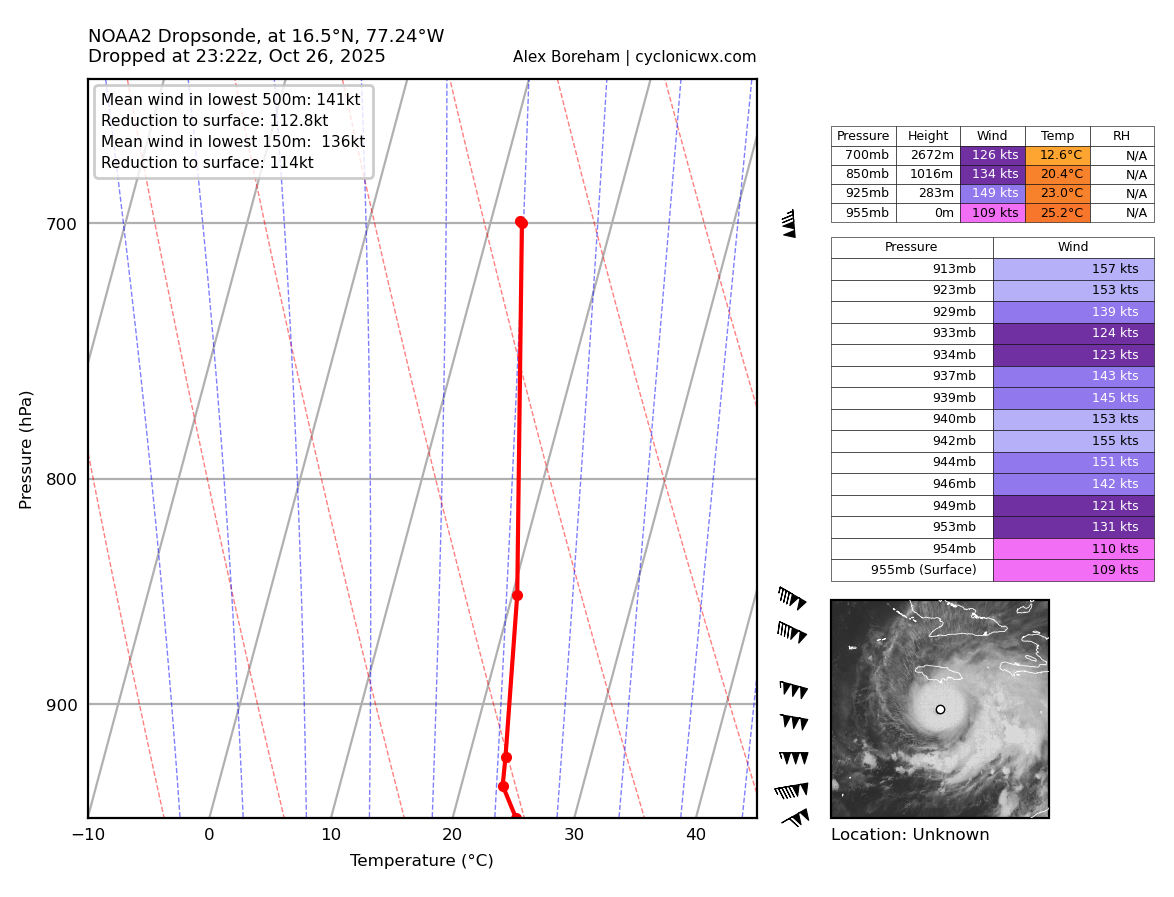
~
Watching meso imagery occasionally I observed a convective burst through the eyewall about a 1/3 the way through recon (between first and second eyewall crossings)... this indicated some additional strengthening should be happening with the western eyewall and core of the hurricane as the WV imagery during this time has cooling tops over the western portion. Also visible in this nice combined obs. chart below from cyclonic wx with the high dewpoint during this event... (although its not the same exact position for each eyewall the FLW appear more symmetric in the last pass although it could be a coincidence). I believe we should also expect strengthening over the next several hours based on this ....
~
No sign of ERC soon as far as I can tell: there was a 60-65% prediction earlier from M-PERC around 18Z, but it didn't seem plausible looking at the ring product, and a subsequent microwave pass dropped it substantially.
No sign of it from earlier lightning data, but I'm used to referencing CIRA's slider for lightning meso and it is far behind (23:50Z). Referencing cyclonicwx which has 10min lightning, I didn't see any hints
~
chart from cycloncwx:
The first pass is W->E, then NE -> SW, then SE -> NW..
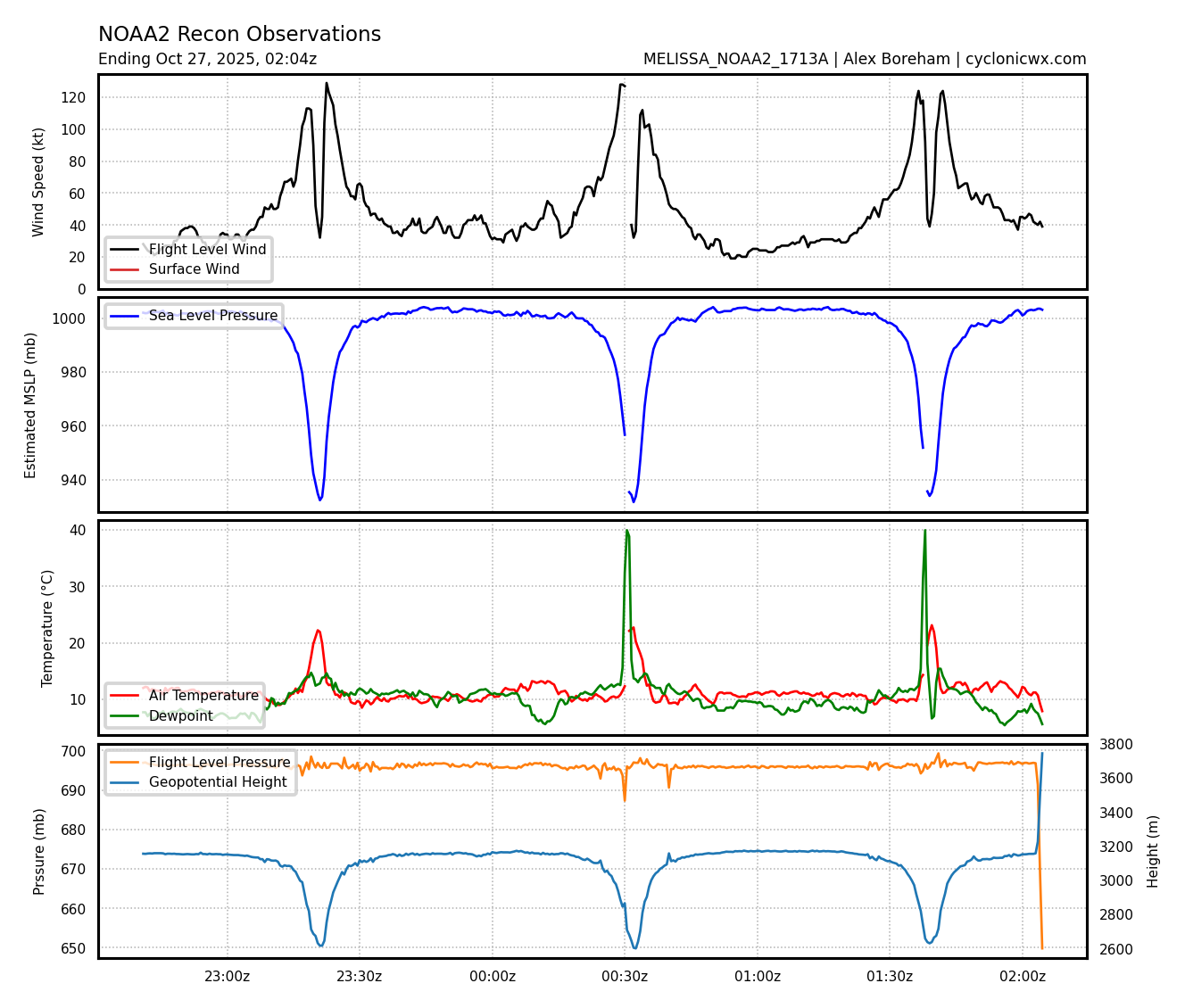
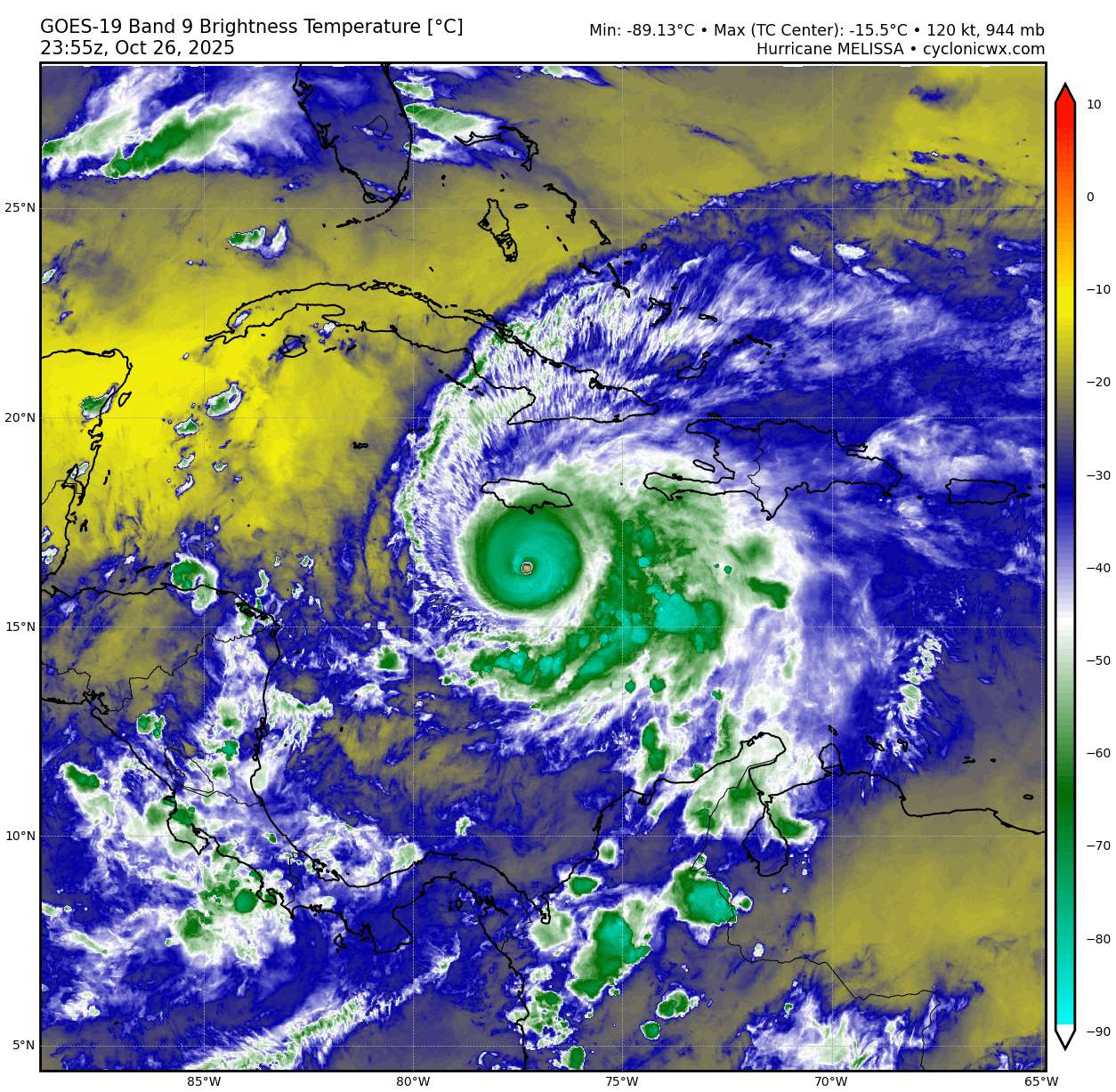
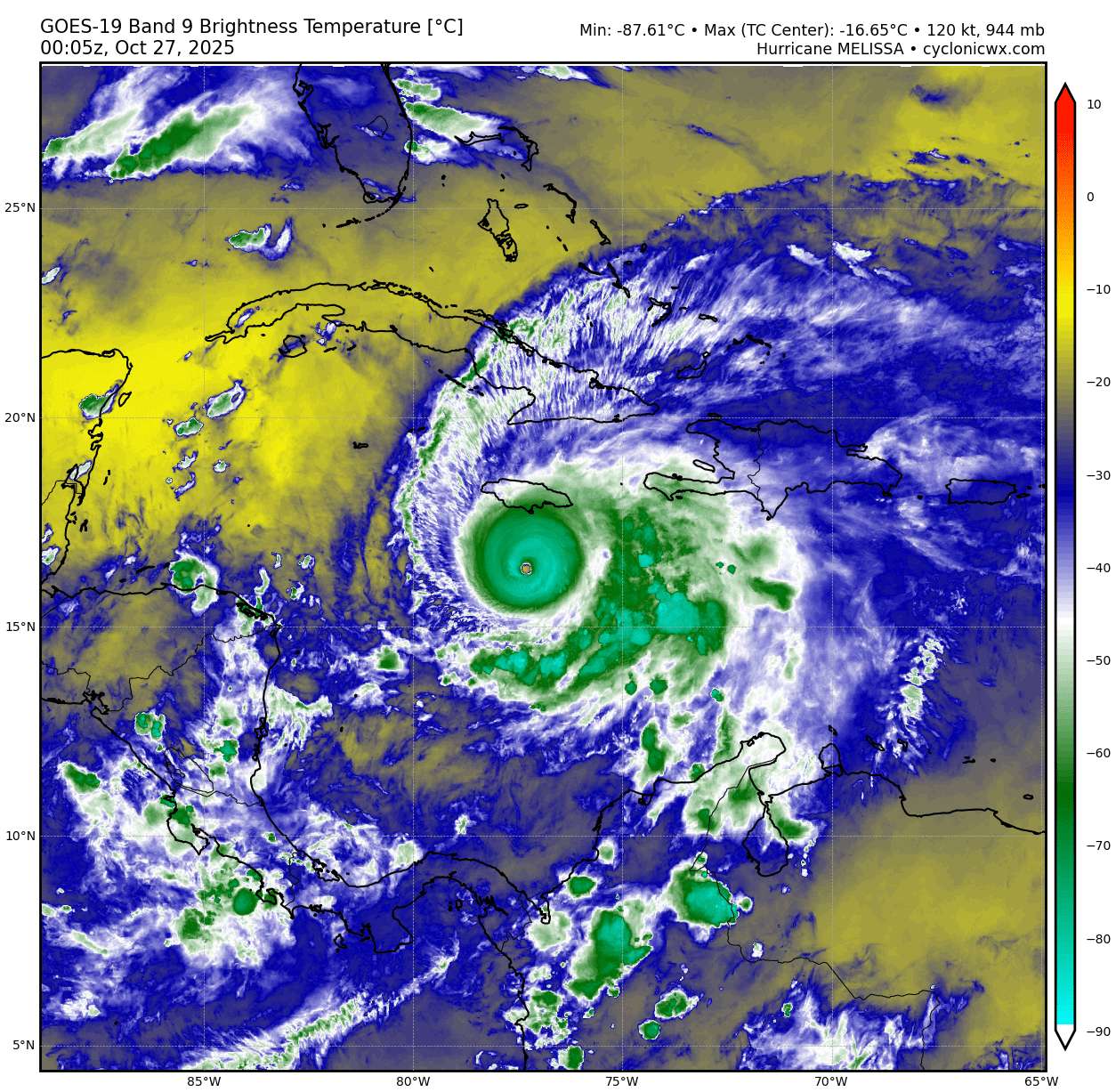
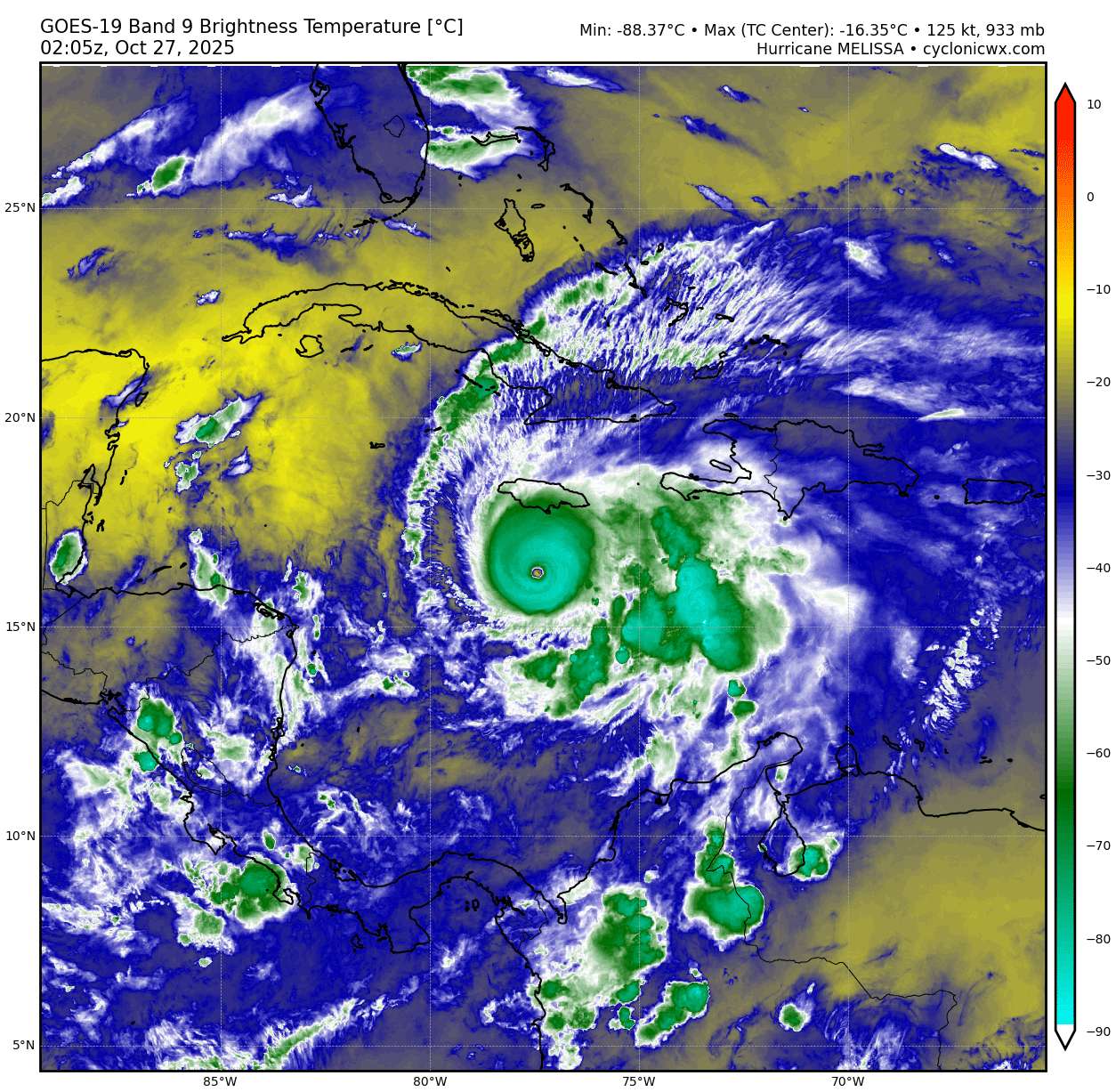
From the VDMs, the eyewall is circular, closed type and reportedly shrunk by about 3 NM during the recon (from 15 to 12 NM) between the first and second pass (an hour apart).
~
For Google/18Z:
In previous runs the LMI in terms of pressure was reached on 28/00Z, but now with the latest run, from examining the mean it looks like 28/06Z (in a few hours) is more likely, but there also seems to be more variation so I am indicating that it is more likely to happen before 28/00Z then previously; this also makes it more likely to deepen rapidly and a subsequent ERC more likely before a Jamaican landfall if it happens early enough (which I mention since I recall from a day ago some of the HAFS models showed further deepening was possible as it approached the Jamaican coast)
For landfall, the naive mean of interpolated track indicates a daytime landfall on 28th but with quite a bit of spread to the point of very early morning to late evening...
(First entry) mean vmax: 124.7, mean valid time: 2025-10-28 16:20 UTC
67% CI vmax: (111.0 kt - 134.7 kt)
95% CI vmax: (101.1 kt - 147.1 kt)
67% CI valid time: (2025-10-28 12:28 UTC - 2025-10-28 20:06 UTC)
95% CI valid time: (2025-10-28 07:45 UTC - 2025-10-28 22:42 UTC)
Given its current cat.4 intensity, from my understanding any ERC then from now on will likely mean that the storm will likely have much less chance for further deepening as the stronger the storm the longer it takes the ERC to complete (if I recall its usually something like a 24 hour event from start to finish for a high end hurricane), and given as of 27/04Z now there are ~ 36 hours to landfall it seems too tight timewise for a scenario where even a ERC that happens now would require significant RI near landfall again to deepen enough again.
So if a ERC becomes likely I would expect the LMI to be whatever it was at the inflection time. Anyway, this is what I interpret Google as possibly suggesting -- where the most likely is intensification soon, after which an ERC becomes more likely)..
~
Lastly checked various satellite estimates:
Noted CIMSS adjusted raw data T are up to 8.2 (hitting 24hr limit constraints now), though not truly reliable lately given recon they do hint I might be correct about the ongoing intensification that Google indicated...
2025OCT27 021021 7.3 911.3 149.0 7.3 7.8 7.8 NO LIMIT OFF OFF OFF OFF 17.82 -77.83 EYE 15 IR 73.8 16.25 77.42 ARCHER GOES19 19.2
2025OCT27 024021 7.4 908.3 152.0 7.4 8.0 8.0 NO LIMIT OFF OFF OFF OFF 19.14 -78.47 EYE 16 IR 73.8 16.25 77.45 ARCHER GOES19 19.2
2025OCT27 031021 7.5 905.1 155.0 7.5 8.1 8.2 3.7T/24hr OFF OFF OFF OFF 18.30 -79.68 EYE 15 IR 73.8 16.25 77.45 ARCHER GOES19 19.2
~
D-MINT also shows strengthening
2025OCT27 0305 16.30 -77.50 TROPICS03 924 142 136 149
~
AiDT up to 152 kt now ..
20251027 034021 161 152 125
~
D-PRINT doesnt show as high numbers as earlier today, but the current official intensity of 125kt is still below the 25th percentile..
2025OCT27 0310 16.25 -77.45 928 137 130 144
2025OCT27 0340 16.28 -77.51 929 137 129 144
~
SATCON has steadily increased, now at 149kt, 926mb
2025 AL 13 300.049 2025OCT27 011021 16.28 77.37 2 926 149
~ ~
Based on the above I am going to again reference an adjusted Google/18Z distribution by the last center dropsonde alone (from the earlier 01Z recon -- there is another recon mission going on now that hasn't reached the center yet), and bet aggressively given I still see no evidence yet of an ERC.
I note the lowest end bin now 0% (I did check without an adjustment and 6% (or 3/50) do reach below 900mb), so although betting aggressively I don't go below 1.5% for this bin considering the CDF of the (lowest) 1-sided bin would not be accurately reflected in a 50 member ensemble (taking the 1.5% from the most likely bin)... Additionally I shift the 2% from the 940-950 bin to a bin lower to the current highest logically possible bin (the 933 official min. advisory from 03Z)
Minimum Estimated Dropsonde Pressure: 932.9mb at 23:21z
18Z run Google mean track points:
2510262300 ( +16.37, -77.18) 133.1 932.0
2510270000 ( +16.36, -77.24) 135.6 929.6
interpolating...
932.0 + (932.0-929.6) * (-21/60) = 931.16
932.9 - 931.16 = +1.74 mb adjustment
Unadjusted mean min. mslp: 914.620
Adjusted 1.74 mean min. mslp: 916.360
Total models: 50
MSLP bin distribution (% of models):
< 899.5 : 0.0%
[899.5, 909.5) : 22.0%
[909.5, 919.5) : 46.0%
[919.5, 929.5) : 30.0%
[929.5, 939.5) : 0.0%
[939.5, 949.5) : 2.0%
[949.5, 959.5) : 0.0%
[959.5, 969.5) : 0.0%
[969.5, 979.5) : 0.0%
>= 979.5 : 0.0%
manually adjusting becomes..
< 899.5 : 1.5%
[899.5, 909.5) : 22.0%
[909.5, 919.5) : 44.5%
[919.5, 929.5) : 30.0%
[929.5, 939.5) : 2.0%
[939.5, 949.5) : 0.0%
[949.5, 959.5) : 0.0%
[959.5, 969.5) : 0.0%
[969.5, 979.5) : 0.0%
>= 979.5 : 0.0%
Finally I note before betting, magically the market is at 916.5 mb (where the above estimate is at ~ 916.36)
recon has started again.. looks like it has strengthened further in terms of minimum pressure but the winds might still have not yet increased ...
Minimum Extrap. Pressure: 932.4mb at 23:21z
The 937mb center drop had fairly high winds (41 kt) but using the standard reduction, its 932.9 mb.
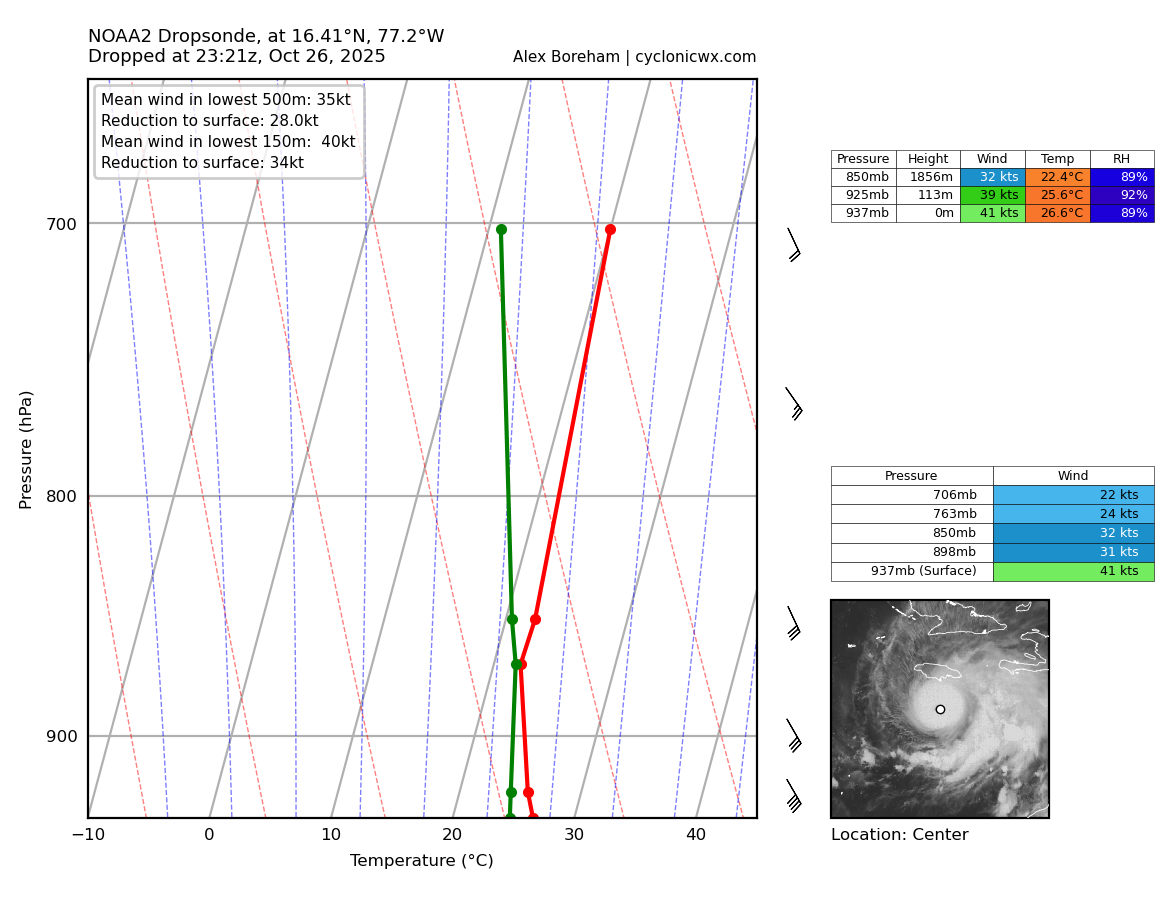
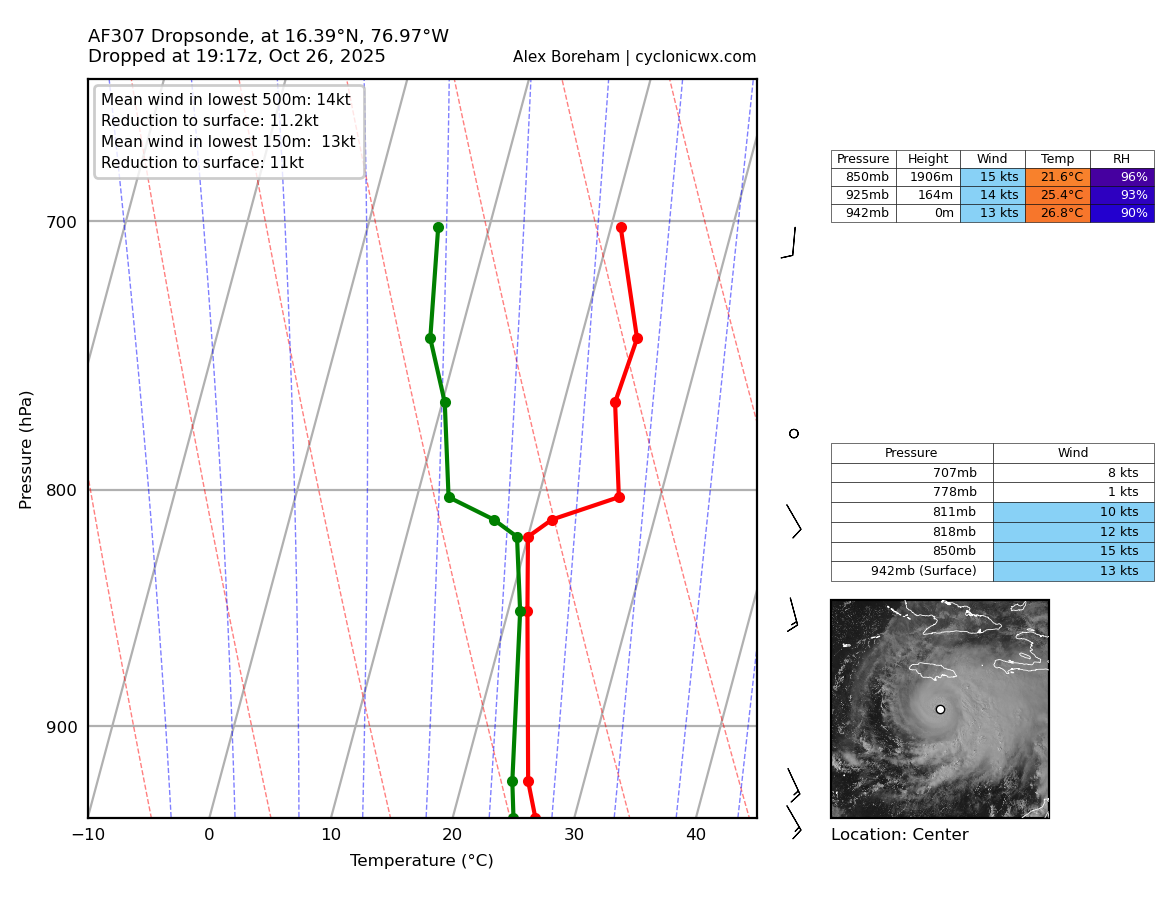
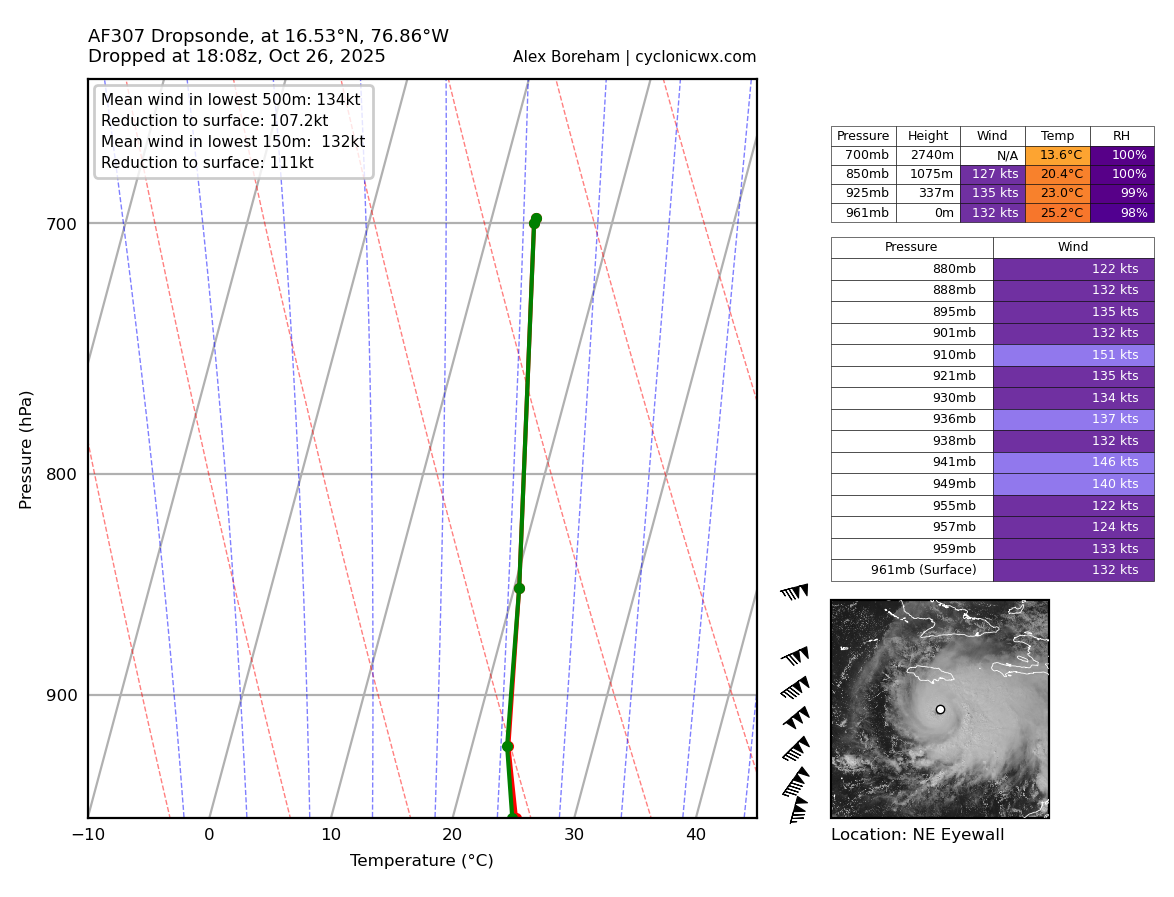
~
(accidentally lost the analysis of what I wrote)...
in short updating on Google/12Z alone again (as it has performed very well so far I think based on track and intensity even if the mean was off on the exact RI periods) using latest recon after reviewing various products, sat imagery, recon, gfs/ships 18Z, google 12Z, 06Z (track error and evaluated last bet's assumptions). (Hard to best aggressively adjusting all the bins...);
quick summary through 19Z ...
over the recent recon (referencing cyclonicwx's site), the 3 last center drops (and min extrap pressure) have been decreasing and based on that, sat imagery (primary band contracting), increase in 18Z best track wind field for all radii, various other products, and timing (getting near sunset, so I expect more convection in the outer most rain band to pick up and improve the RH to near ideal (it has been slightly less so earlier per GFS ships and examining WV imagery -- this is only temporary I believe while the storm strengthens), I believe its going through another intensification phase and expect it won't stop soon...
Given how aggressive they have been so far upgrading this season, I am expecting they will upgrade for the 21Z advisory to at least 130 kt based on one of the eyewall dropsondes and other satellite estimates (despite the MBL/FLW supporting lower numbers)... the satellite estimates though remain high, latest pair of DVTS are 6.5/7.0 and 7.0/7.0, objective ADT , AiDT, D-PRINT, etc are all significantly higher, and even satcon is slightly above 130 kt, possibly they may make it 135kt based on the trend...
~
Adjusting Google 12Z..
Minimum Extrap. Pressure: 939.9mb at 19:19z
Edit: needed to redo the calculations from a couple of errors (pasted wrong pressure measurement, wrong sign in calculation -- only a tiny difference in %)
Minimum Estimated Dropsonde Pressure: 940.7mb at 19:17z
12Z run Google mean track points:
2510261900 ( +16.50, -76.95) 124.3 940.8
2510262000 ( +16.49, -77.03) 125.5 939.5
interpolating...
940.8 + (940.8-939.5) *(-19 / 60) ~= 940.4
940.7 - 940.4 = +0.3 mb adjustment
Unadjusted mean min. mslp: 914.710
Adjusted 0.3 mean min. mslp: 915.010
Total models: 50
MSLP bin distribution (% of models):
< 899.5 : 4.0%
[899.5, 909.5) : 20.0%
[909.5, 919.5) : 48.0%
[919.5, 929.5) : 24.0%
[929.5, 939.5) : 2.0%
[939.5, 949.5) : 2.0%
[949.5, 959.5) : 0.0%
[959.5, 969.5) : 0.0%
[969.5, 979.5) : 0.0%
>= 979.5 : 0.0%
After being too generous earlier with the previous couple advisories they are now conservative and stick to all of the recon, upgrading it to 125 kt.
Reposting the 21Z discussion
Hurricane Melissa Discussion Number 22
NWS National Hurricane Center Miami FL AL132025
500 PM EDT Sun Oct 26 2025
After an earlier pause in intensification, this afternoon's Air
Force Reserve reconnaissance mission has found Melissa intensifying
again. The minimum pressure has fallen 12 mb from this morning
NOAA-P3 mission, with the last dropsonde indicating a minimum
pressure of 941 mb, and the plane reported a shrinking eyewall down
to 6 n mi in diameter. In addition to the low pressure, the
satellite presentation of Melissa remains very impressive, with
1-minute visible satellite images from a GOES-19 meso-sector showing
a very clear eye with a stadium effect. The eye temperature on water
vapor imagery has continued to warm, while the thick ring of eyewall
cloud tops remains between -75 to -80 C around the eye. The
presentation of Melissa on radar reflectivity from Kingston, Jamaica
has also improved, though there still appear to be hints of a moat
forming around the inner eyewall, though without an obvious
secondary eyewall formation yet. Subjective Dvorak CI-numbers from
both SAB and TAFB were T7.0/140 kt, with objective satellite
estimates between 132-143 kt. However, Melissa's peak winds from the
last couple of recon missions have been lagging the satellite-based
estimates. The last fix had peak 700 mb flight level winds of only
129 kt, but a dropsonde launched in the north eyewall also reported
a 500 m layer average of 142 kt, with an earlier dropsonde in the NE
eyewall with a surface wind gust of 131 kt. This data is enough to
raise the maximum sustained winds of 125 kt, and given the satellite
presentation, this could be conservative.
Melissa continues to move slowly westward, estimated at 270/4 kt.
The hurricane has been moving a little faster to the west today, and
this motion will likely continue for another 12-18 hours while the
narrow mid-level ridge to the north remains in place. Soon, a
short-wave trough will be moving into the SE United States, and this
feature should create a weakness that Melissa will turn
sharply northeast into, as it gradually accelerates. The track
guidance has shifted a little westward again this cycle, and the NHC
track forecast was nudged a little west again, but still shows
landfall on Tuesday morning along the south coast of Jamaica. There
remain some timing differences thereafter, but a second landfall is
anticipated along the southeastern Cuba coast by Tuesday night or
early Wednesday morning. As Melissa then accelerates into the
southwestern Atlantic, it will move through the Bahamas and
potentially approach Bermuda by the day 4-5 time frame, with a
reinforcing trough helping to kick it farther out to sea. The latest
NHC track forecast is a little west in the first 24-60 h, but falls
back near the previous forecast track thereafter. The track is
roughly a blend of the reliable HFIP Corrected Consensus Approach
(HCCA) and Google Deep Mind ensemble mean (GDMI).
Now that Melissa is intensifying again, it seems more clear that the
earlier pause in intensification was a temporary oscillation, and
the hurricane now appears poised to intensify more in the
short-term. The latest NHC intensity forecast shows a little more
intensification in 12 h, but continues to show a peak intensity of
140 kt, which is supported by HAFS-B which shows landfall of Melissa
as a catastrophic Category 5 hurricane. The Google DeepMind ensemble
members also continue to indicate this peak, with now 48/50 members
reaching this lofty intensity. However, inner-core processes like
ERCs could occur at any time, and the current small eye of Melissa
likely suggests an ERC could begin in the next 24 hours or so,
though it is very difficult to predict these occurrences with much
skill. After landfall in Jamaica, Melissa will likely weaken some
due to the interaction with that Island's high terrain, but it is
still expected to be a major hurricane when crossing the Cuba
coastline on Tuesday night. After emerging into the southwestern
Atlantic Ocean, increasing vertical wind shear should continue
gradual weakening through the end of the forecast, with the
possibility that Melissa could start extratropical transition by day
5. The NHC intensity forecast continues to be on the high side of
the guidance, but falls closer to the HCCA and IVCN aids towards the
end of the forecast period.
Key Messages:
1. Jamaica: Seek shelter now. Damaging winds and heavy rainfall
tonight and Monday will cause catastrophic and life-threatening
flash flooding and numerous landslides before potentially
devastating winds arrive Monday night and Tuesday morning.
Extensive infrastructural damage, long-duration power and
communication outages, and isolation of communities are expected.
Life-threatening storm surge and damaging waves are expected along
portions of the southern coast Monday night and Tuesday morning.
2. Haiti and the Dominican Republic: Catastrophic and
life-threatening flash flooding and landslides are expected across
southwestern Haiti and southern portions of the Dominican Republic
through midweek. In Haiti, extensive infrastructural damage and
isolation of communities is likely. Although winds have temporarily
decreased on the Tiburon peninsula, they are likely to increase
again across much of western Haiti on Tuesday.
3. Eastern Cuba: Life-threatening storm surge is expected along
portions of the southern coast of eastern Cuba late Tuesday and
Tuesday night. Damaging winds and heavy rainfall with
life-threatening and potentially catastrophic flash flooding and
landslides are also expected beginning on Monday. Preparations
should be rushed to completion.
4. Southeast Bahamas and the Turks and Caicos: Monitor Melissa
closely. There is an increasing risk of a significant storm surge,
damaging winds, and heavy rainfall Tuesday and Wednesday. Watches
will likely be required early Monday.
FORECAST POSITIONS AND MAX WINDS
INIT 26/2100Z 16.4N 77.2W 125 KT 145 MPH
12H 27/0600Z 16.4N 77.7W 135 KT 155 MPH
24H 27/1800Z 16.6N 78.2W 140 KT 160 MPH
36H 28/0600Z 17.2N 78.2W 140 KT 160 MPH
48H 28/1800Z 18.4N 77.5W 115 KT 130 MPH...INLAND OVER JAMAICA
60H 29/0600Z 20.0N 76.1W 105 KT 120 MPH...ON THE SE CUBA COAST
72H 29/1800Z 22.1N 74.4W 90 KT 105 MPH...OVER WATER
96H 30/1800Z 28.0N 69.5W 80 KT 90 MPH
120H 31/1800Z 37.0N 60.0W 70 KT 80 MPH
$$
Forecaster Papin
Latest 15Z NHC advisory keeps it at 953mb, 120 kt. I updated with center drop from 11Z and adjust from google/06Z alone (+8.5 mb) not using NHC 15Z.
ggl pnt:
2510261100 ( +16.32, -76.44) 122.1 943.1
~
written <15Z - Long thread with intermediate reanalysis of the 06 tcvitals and 09Z advisory
~
The NHC raised it to a cat. 4 with the 09Z advisory (944mb 120kt) based on AI satellite-derived estimates - CIMSS D-PRINT, AiDT
Recent recon data seems to indicate that might possibly have been an overestimate at the time (at least in terms of pressure). Don't knowwhat support they used for the current best track 12Z wind speed of 120kt...seems a bit on the high end for 952mb based on the recon data (it is a small sample of dropsondes so might there be undersampling, or not great samples of the eyewall); other satellite derived estimates are higher though, and some recent estimates from satellite data put it at cat 5 now.
DVTS from SAB (7.0/7.0), D-PRINT ( operational (OSPO) ADT/AiDT:
(OSPO ADT/AiDT):
Date Time ADT AIDT Best
20251026 131021 137 137 120
20251026 135021 143 139 120
Recent recon (referencing cyclonicwx excellent recon charts):
from ~10:30-13:30Z
Minimum Estimated Dropsonde Pressure: 951.6mb at 11:00z
Minimum Extrap. Pressure: 948.4mb at 12:18z
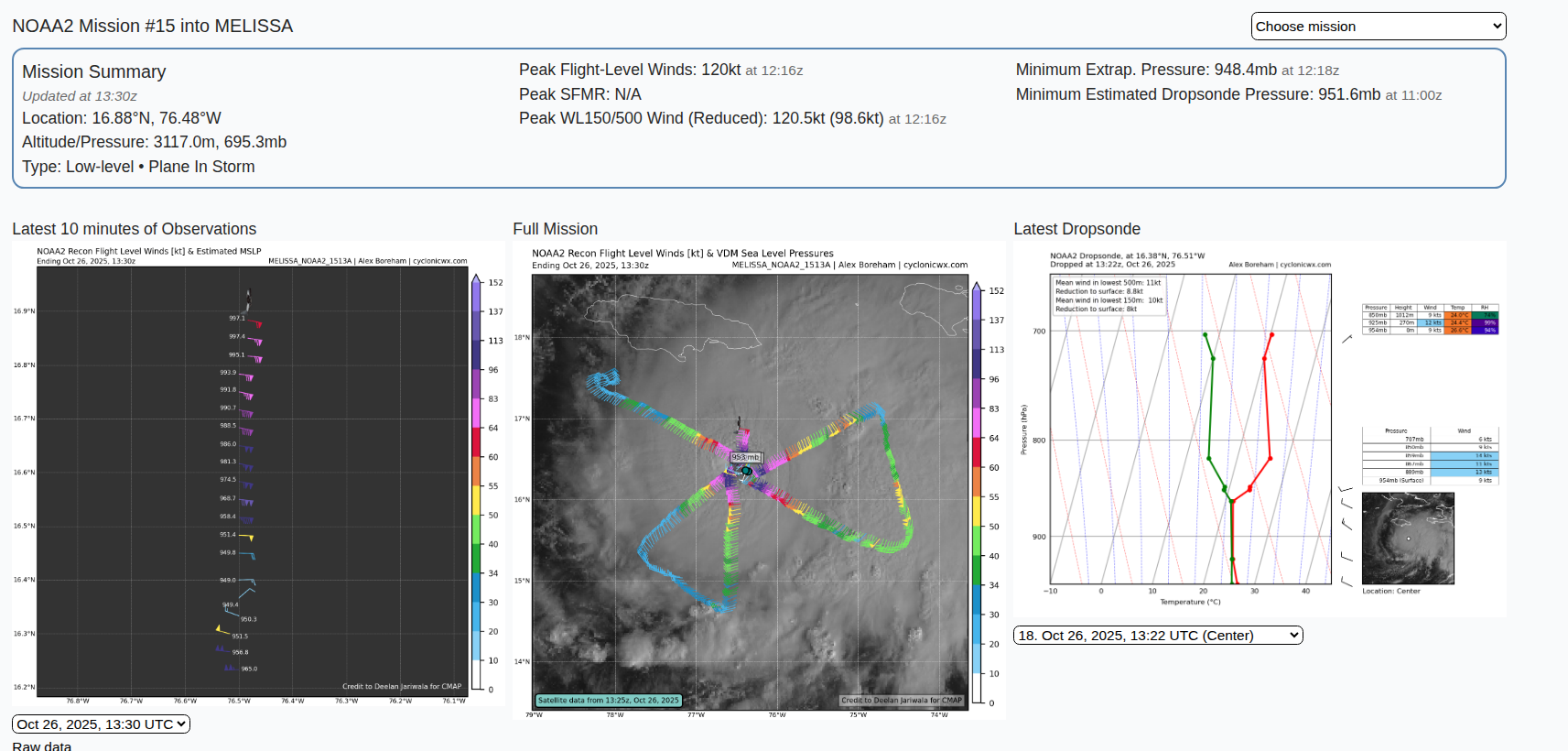
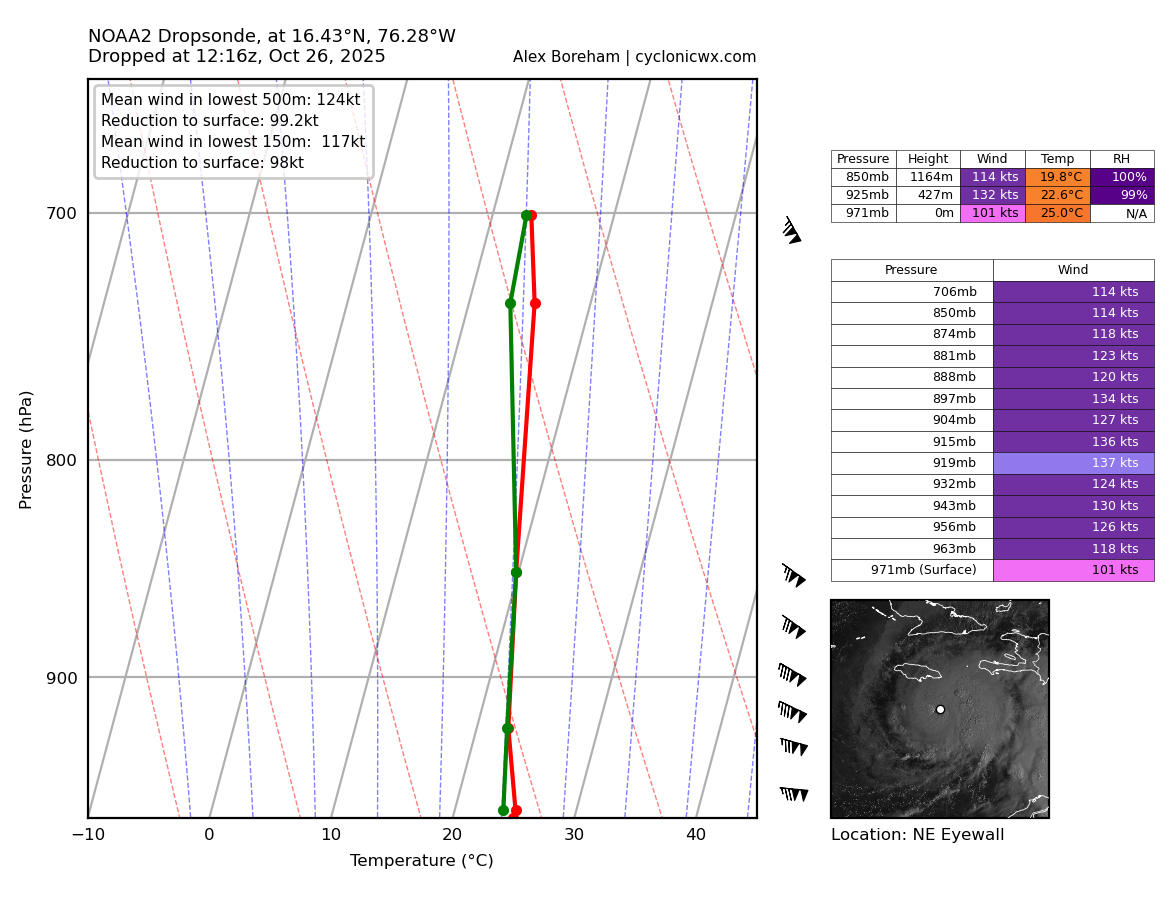
~
Recent (CIMSS) D-PRINT:
Date Time TC_Lat TC_Lon MSLP VMAX VMAX_25percentile VMAX_75percentile
20251026 055021 94 104 90
20251026 062021 104 111 110
20251026 063021 104 112 110
20251026 072021 112 116 110
20251026 075021 112 119 110
20251026 080021 115 120 110
20251026 083021 115 123 110
20251026 092021 117 124 110
20251026 094021 117 126 110
20251026 102021 119 127 110
20251026 104021 119 128 110
20251026 112021 124 130 110
20251026 115021 127 132 110
20251026 121021 129 133 120
20251026 124021 134 135 120
20251026 131021 137 137 120
20251026 135021 143 139 120
D-PRINT verification chart:
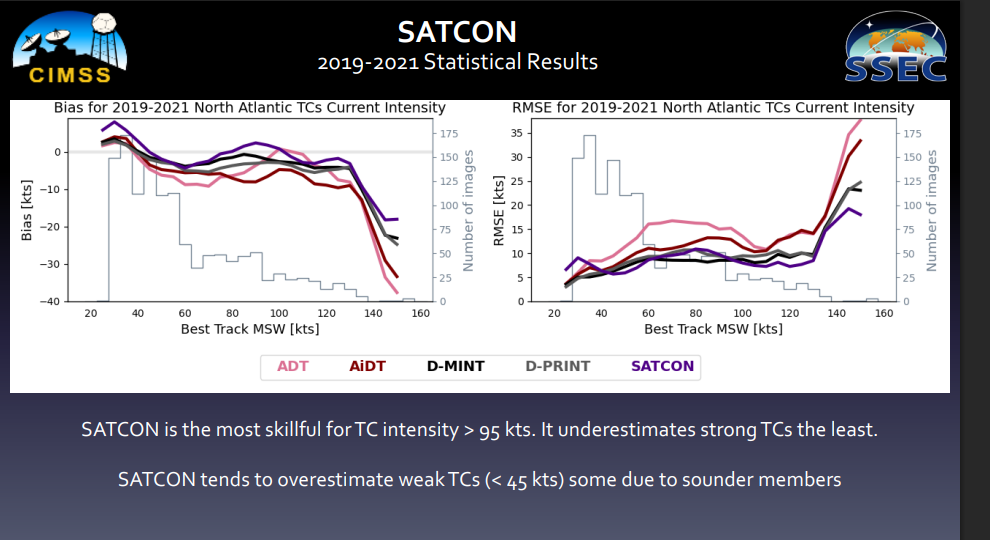
~
Restrospectively based on the above and below data, it looks like the 06Z initializations for the models were too strong (looking at the tcvitals archive) and the 09Z advisory which had it at 944 mb also seems too strong; before 06Z it still hadn't yet cleared out an eye (looks like the eye was a bit chaotic as it did so) but it did clear it out before 09Z, and since then to 13Z there hasn't been any reorganization apparent); regardless for the 09Z advisory they relied on AiDT and D-PRINT - both AI models based on sat imagery with lower RMSE generally compared to other satellite estimates (~10 kt), but the verification statistics for major hurricanes, D-PRINT for instance, might be a bit sparse (eyeballing their chart for 2019-2021 looks like ~200 cases for major hurricanes), and although they had negative bias, the current recon indicates ADT,AiDT,D-PRINT are over-estimating the current intensity from recon. The dropsondes accuracy is +- 0.5 mb, while the RMSE for D-PRINT is generally 10kt.
The CIMSS SATCON product which is supposed to reduce these biases... as of last update supported only 956 mb, 109 kt for 06Z (this has data not available to the previous advisory of course)
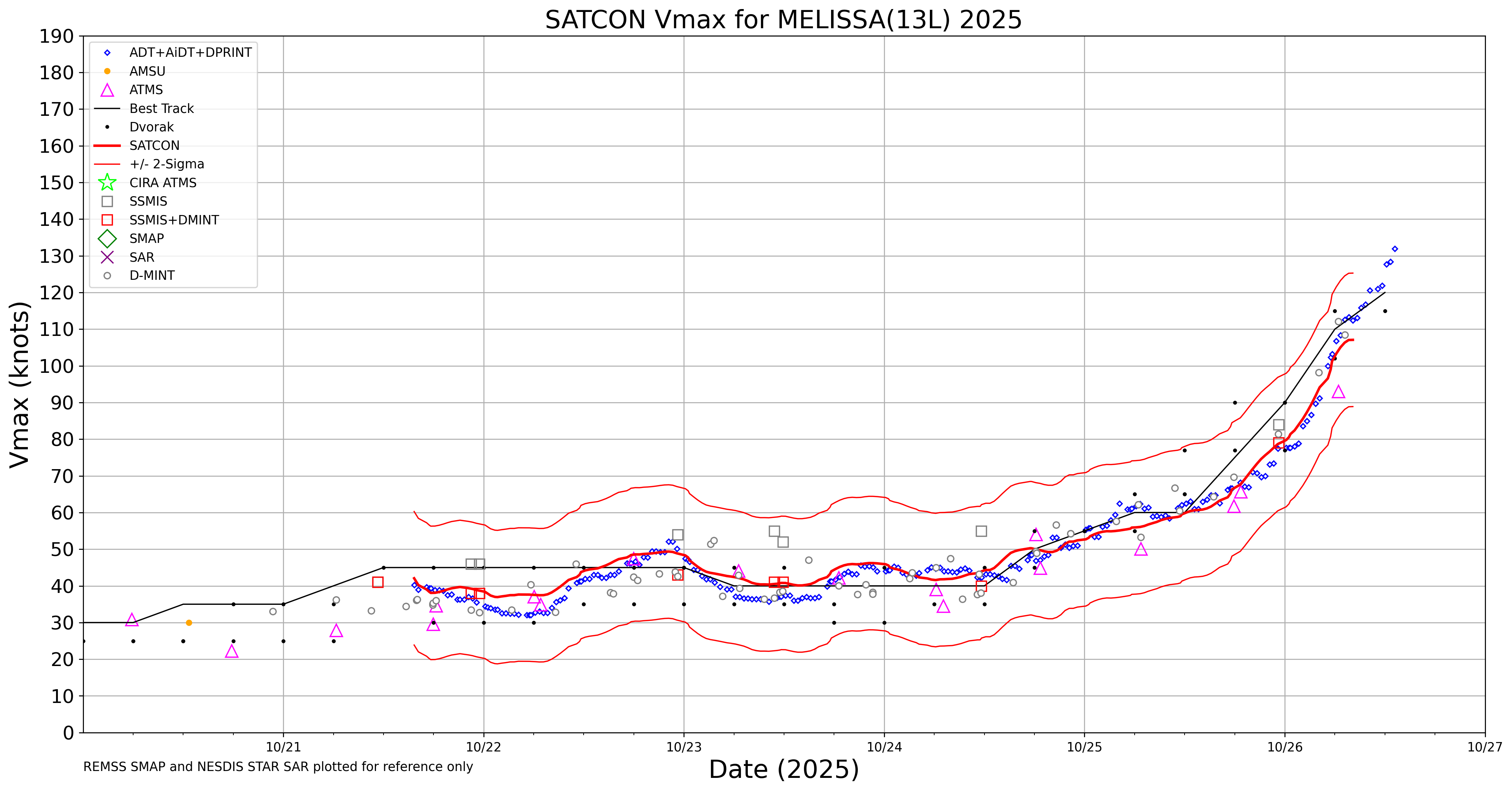
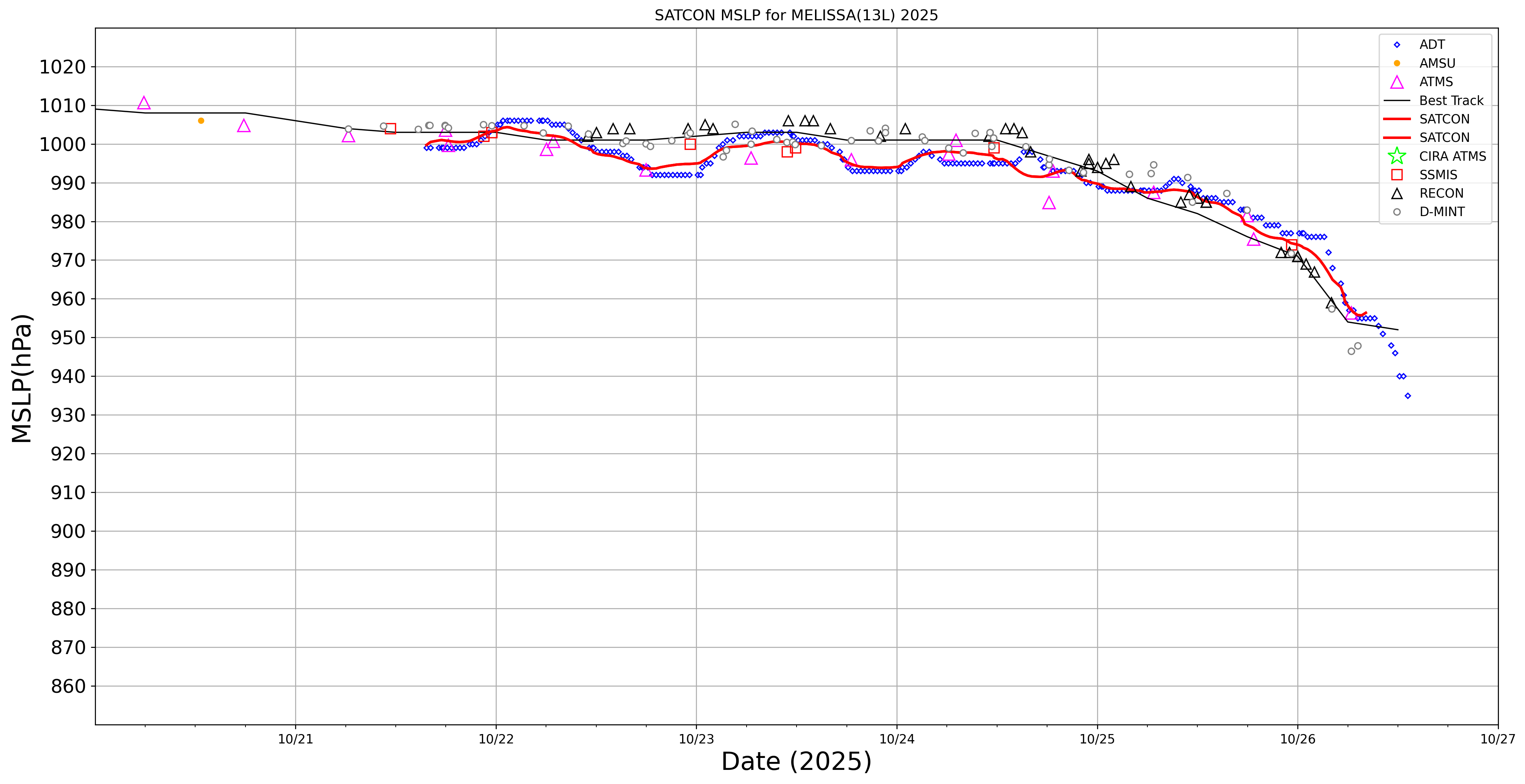
D-MINT (which only recently became available) supports 110 kt for 06Z:
2025OCT26 0626 16.40 -76.09 ATMS-N21 946 112 106 119
2025OCT26 0712 16.30 -76.18 AMSR2 948 108 102 115 DVTS fixes:
AL, 13, 202510260600, 10, DVTS, CI, , 1630N, 7620W, , 1, 115, 2, , , , , , , , , , , , , , , , , L, SAB, SL, IM, 1, 6060 /////, , , GOES19, LLCC, T, DT=6.5 BO EYE MET=5.0 PT=5.5 FTBO CON
AL, 13, 202510260600, 10, DVTS, CI, , 1640N, 7610W, , 1, 102, 2, 960, 2, DVRK, , , , , , , , , , , , , , L, TAFB, EC, I, 1, 5555 /////, , , GOES19, CSC, T, Clear cut Data T = 6.0 via eye patternAL, 13, 202510261200, 10, DVTS, CI, , 1640N, 7640W, , 1, 115, 2, 948, 2, DVRK, , , , , , , , , , , , , , L, TAFB, EA, VI, 1, 6060 /////, , , GOES19, CSC, T, Constrained by Dvorak rules (12 h). Data T clear cutOSPO DVTS (note DT of 6.5 and 7.0 for 06Z and 12Z):
TXNT28 KNES 260639
TCSNTL
A. 13L (MELISSA)
B. 26/0600Z
C. 16.3N
D. 76.2W
E. ONE/GOES-E
F. T6.0/6.0
G. IR/EIR/SWIR
H. REMARKS...OW EYE SURROUNDED BY CMG AND EMBEDDED IN W RESULTS IN AN E#
OF 6.0 WITH AN EADJ OF 0.5 FOR A DT OF 6.5. THE 6-HOUR AVG GIVES 6.1 SO
THIS DOES NOT JUSTIFY BREAKING CONSTRAINTS AT THIS TIME. THE MET EQUALS
5.0 BASED ON A RAPIDLY DEVELOPING 24-HOUR TREND AND THE PT EQUALS 5.5. THE
FT IS BASED ON CONSTRAINTS DUE TO THE LIMIT OF 1.0 T-NUMBER CHANGE IN
6 HOURS.
I. ADDL POSITIONS
NIL
...LINER
TXNT28 KNES 261220
TCSNTL
A. 13L (MELISSA)
B. 26/1200Z
C. 16.4N
D. 76.4W
E. ONE/GOES-E
F. T7.0/7.0
G. IR/EIR/VIS
H. REMARKS...SYSTEM CHARACTERIZED BY A WMG EYE SURROUNDED BY W AND
EMBEDDED IN W FOR A DT=7.0 MET=6.0 PT=6.5. THE FT IS BASED ON THE 6 HOUR
AVERAGE DT OF 6.8 WHICH JUSTIFIES BREAKING TRADITIONAL DVORAK CONSTRAINTS.
I. ADDL POSITIONS
NIL
...FISHER
Thus, the subjective dvorak for 12Z are mixed at 6.0/6.0 and 7.0/7.0 (SAB breaking constraints and TAFB not); blending them puts it at a cat 4 (935mb, 127kt).
(wikipedia chart:)
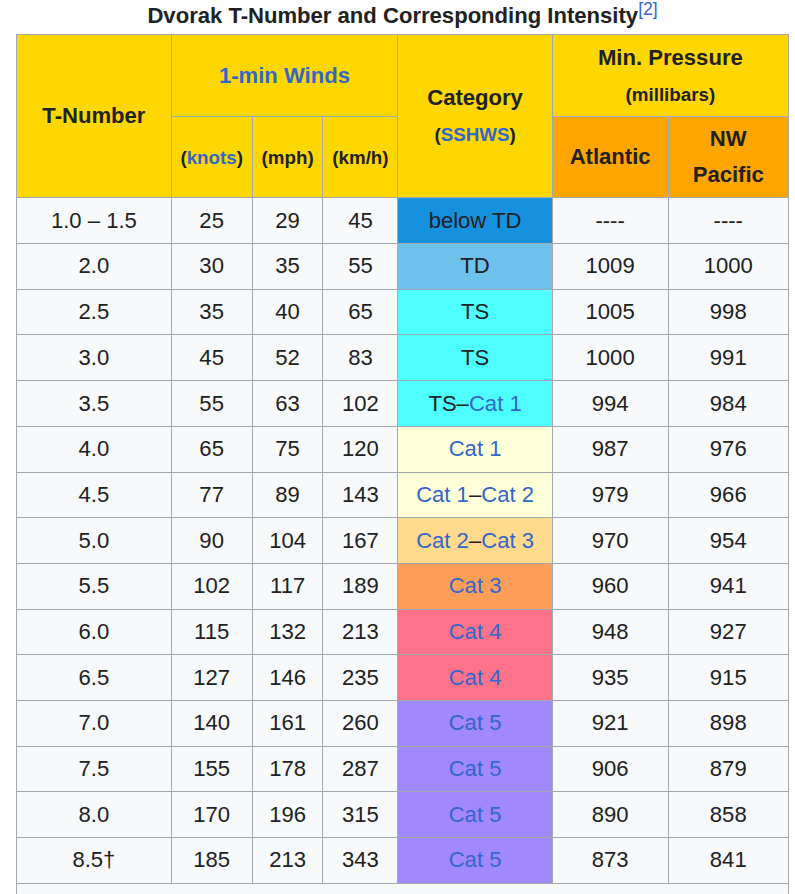
recent CIMSS ADT for reference:
2025OCT26 054021 5.3 958.9 97.2 5.3 5.6 7.4 1.3T/6hr OFF OFF OFF OFF -24.05 -77.67 EYE -99 IR 80.3 16.22 76.05 ARCHER GOES19 19.0
2025OCT26 061021 5.4 957.0 99.6 5.4 5.6 7.2 1.3T/6hr OFF OFF OFF OFF -28.36 -77.17 EYE -99 IR 80.3 16.22 76.08 ARCHER GOES19 19.0
2025OCT26 064021 5.5 957.0 102.0 5.5 5.6 7.5 1.3T/6hr OFF OFF OFF OFF -10.11 -77.30 EYE -99 IR 80.3 16.22 76.11 ARCHER GOES19 19.0
2025OCT26 071021 5.6 954.9 104.6 5.6 5.7 7.7 1.3T/6hr OFF OFF OFF OFF 6.15 -77.44 EYE 13 IR 80.3 16.33 76.12 ARCHER GOES19 19.2
2025OCT26 074021 5.6 954.9 104.6 5.6 5.7 7.6 1.3T/6hr OFF OFF OFF OFF 9.52 -76.78 EYE 15 IR 62.0 16.33 76.15 ARCHER GOES19 19.2
2025OCT26 081021 5.6 954.9 104.6 5.6 5.7 7.6 1.3T/6hr OFF OFF OFF OFF 8.45 -76.98 EYE 17 IR 62.0 16.30 76.23 ARCHER GOES19 19.1
2025OCT26 084021 5.6 954.9 104.6 5.6 5.7 7.4 1.3T/6hr OFF OFF OFF OFF -0.11 -76.40 EYE 12 IR 62.0 16.28 76.23 ARCHER GOES19 19.1
2025OCT26 091021 5.6 954.9 104.6 5.6 5.7 7.2 1.3T/6hr OFF OFF OFF OFF 4.69 -75.23 EYE 14 IR 62.0 16.30 76.25 ARCHER GOES19 19.1
2025OCT26 094021 5.7 952.7 107.2 5.7 5.9 7.3 1.3T/6hr OFF OFF OFF OFF 12.77 -75.03 EYE 15 IR 62.0 16.30 76.26 ARCHER GOES19 19.1
2025OCT26 101021 5.8 950.6 109.8 5.8 6.1 7.5 1.3T/6hr OFF OFF OFF OFF 15.67 -76.13 EYE 15 IR 62.0 16.35 76.31 ARCHER GOES19 19.2
2025OCT26 111021 5.9 948.4 112.4 5.9 6.3 7.7 1.3T/6hr OFF OFF OFF OFF 16.56 -76.78 EYE 15 IR 62.0 16.32 76.40 ARCHER GOES19 19.2
2025OCT26 114021 6.0 946.2 115.0 6.0 6.5 7.2 1.3T/6hr OFF OFF OFF OFF 3.92 -74.85 EYE -99 IR 62.0 16.30 76.15 ARCHER GOES19 19.1
2025OCT26 121021 6.3 939.9 122.2 6.3 6.7 7.5 1.3T/6hr OFF OFF OFF OFF 17.11 -76.13 EYE 14 IR 62.0 16.30 76.46 ARCHER GOES19 19.1
2025OCT26 124021 6.3 939.7 122.2 6.3 6.8 7.4 1.3T/6hr OFF OFF OFF OFF 16.90 -75.30 EYE 16 IR 62.0 16.35 76.44 ARCHER GOES19 19.2
2025OCT26 131021 6.5 935.3 127.0 6.5 6.9 7.3 1.3T/6hr OFF OFF OFF OFF 14.95 -74.81 EYE 15 IR 62.0 16.37 76.47 ARCHER GOES19 19.2
CIMSS SATCON (hasn't been updated past 08Z):
2025 AL 13 299.007 2025OCT26 001021 16.68 75.63 2 974 80
2025 AL 13 299.021 2025OCT26 003021 16.68 75.63 2 973 82
2025 AL 13 299.028 2025OCT26 004021 16.68 75.66 2 973 82
2025 AL 13 299.049 2025OCT26 011021 16.64 75.74 2 972 85
2025 AL 13 299.069 2025OCT26 014021 16.65 75.76 2 970 87
2025 AL 13 299.090 2025OCT26 021021 16.65 75.77 2 970 90
2025 AL 13 299.111 2025OCT26 024021 16.41 75.88 2 969 93
2025 AL 13 299.132 2025OCT26 031021 16.40 75.91 2 970 91
2025 AL 13 299.153 2025OCT26 034021 16.39 75.94 2 966 95
2025 AL 13 299.174 2025OCT26 041021 16.22 75.97 2 964 97
2025 AL 13 299.215 2025OCT26 051021 16.22 76.02 2 960 104
2025 AL 13 299.229 2025OCT26 053021 16.22 76.02 2 958 106
2025 AL 13 299.236 2025OCT26 054021 16.22 76.05 2 957 107
2025 AL 13 299.257 2025OCT26 061021 16.22 76.08 2 956 109
2025 AL 13 299.278 2025OCT26 064021 16.22 76.11 2 954 112
2025 AL 13 299.299 2025OCT26 071021 16.33 76.12 2 953 114
2025 AL 13 299.319 2025OCT26 074021 16.33 76.15 2 953 115
2025 AL 13 299.340 2025OCT26 081021 16.30 76.23 2 953 114~
I do note there was a very high SAR winds estimate for last night 25/23Z supporting 100 kt for 00Z (this was far above everything else at the time though, including on-going recon with a center-drop during that time)
Profile from OSPO (non-operational version) (OSPO operational version is also 100 kt though)
Platform: RCM-1
Acquisition Date: 2025-10-25 23:16:47 UTC
Storm Name: AL132025 / MELISSA
Storm ID: AL13
Storm Center Longitude: -75.706
Storm Center Latitude: 16.431
Incidence Angle (Degrees): 48.024
Quadrant 1 NE VMax (kts): 99.56
Quadrant 2 SE VMax (kts): 93.17
Quadrant 3 SW VMax (kts): 94.11
Quadrant 4 NW VMax (kts): 102.95
RMax (nmi): 10.00 - 15.00AL, 13, 202510252315, 50, AIRC, CI, , 1641N, 7568W, , 2, 79, 2, 972, 1, , , , , , , , , , , , , , , , KNHC, NHC, , 700, 2869, 85, 298, 16, 44, 88, 304, 24, 972, 10, 17, 10, , , CI, , 28, , , 10, 14, CNTR DROP 210/12
AL, 13, 202510252316, 30, SAR, C, , 1647N, 7570W, , 3, , , , 3, , , , , , , , , , , , 3, , , , KNHC, LAK, , , , , , , , , RCM-1, , , , , , , , , , , , , , , , , , , 3, (Not sure why the fix file doesn't include the wind speed other than they possibly have eliminated it?
Couldn't edit it properly since I hit max char length, forgot to include tcvitals for 06Z:
NHC 13L MELISSA 20251026 0600 163N 0761W 250 021 0954 1008 0445 57 019 0278 0204 0093 0148 D 0056 0056 0037 0056 72 194N 761W 0037 0028 0028 0037
(satcon was +2 mb compared to this for 06Z)
edit: Expecting NHC upgrade to major hurricane for 03Z advisory as recon supports 100 kt. With FLW with reduction
015300 1634N 07556W 7516 02356 9855 +141 +168 090105 109 /// /// 05
015330 1636N 07557W 7528 02368 9888 +139 +167 087100 111 /// /// 05
022430 1631N 07600W 6983 02947 //// +088 //// 070102 106 084 059 01
022500 1630N 07559W 6953 02958 //// +084 //// 070108 115 097 044 01
Haven’t had a recent Dropsonde yet in last hour
now a major hurricane 100 kt
Hurricane Melissa Discussion Number 19
NWS National Hurricane Center Miami FL AL132025
1100 PM EDT Sat Oct 25 2025
Reports from NOAA and Air Force Reserve Hurricane Hunter aircraft
indicate that Melissa is continuing rapid intensification. The Air
Force aircraft reported flight-level winds of 115 kt in the north
eyewall of the 17 nm wide eye at 700 mb, along with a central
pressure of 967 mb. Based on these data, the initial intensity is
increased to 100 kt, making Melissa a category 3 major hurricane.
The initial motion is now just south of due west or 265/3 kt. A
low- to mid-level ridge to the north of Melissa should steer the
hurricane generally westward at a slow forward speed during the
next 36 h or so. After that time, a deep-layer mid-latitude trough
moving through the southeastern United States will break the ridge,
with Melissa expected to turn northward and then recurve into the
mid-latitude southwesterly flow. The guidance is fairly well
clustered during the first 72 h, with Melissa expected to pass over
Jamaica in 48-60 h and then be near or over eastern Cuba around 72
h. Beyond 72 h, there is some speed and direction spread, but
overall the guidance is in good agreement that Melissa should
accelerate northeastward through portions of the Bahamas into the
Atlantic. The new forecast track is a little to the south and west
of the previous track through 60 h and similar to the previous
track after that time.
Rapid intensification is expected to continue for the next 24-36 h,
and it is possible that during this time Melissa could intensify
even faster than what is currently forecast. The regional hurricane
models show the cyclone peaking before it reaches Jamaica, and
based on this the new forecast keeps a 48-h peak intensity of 140
kt. Afterwards, some inner-core oscillations such as eyewall
replacement cycles could lead to fluctuations in intensity before
Melissa's first landfall in Jamaica. It must be noted that there is
very little practical difference in the overall impacts of a
Category 4 or 5 landfall, and Melissa is expected to be at least
that intensity when it moves over Jamaica. Melissa should weaken
as it interacts with Jamaica and Cuba, although it is still forecast
to be a major hurricane when it nears Cuba. A faster weakening
should occur after passing Cuba when the cyclone encounters strong
shear over the southwestern Atlantic.
This remains a very serious situation, in terms of catastrophic
rainfall, wind, and storm surge hazards for Jamaica, and
preparations should be rushed to completion in the area currently
under a Hurricane Warning.
Key Messages:
1. Jamaica: Seek shelter now. A multi-day period of damaging
winds and heavy rainfall have begun and will cause catastrophic and
life-threatening flash flooding and numerous landslides. Extensive
infrastructural damage, long-duration power and communication
outages, and isolation of communities are expected.
Life-threatening storm surge is likely along portions of the
southern coast early next week.
2. Haiti: Catastrophic and life-threatening flash flooding and
landslides are expected across southwestern Haiti into early next
week, likely causing extensive infrastructural damage and isolation
of communities. Strong winds could last for a day or more over the
Tiburon peninsula.
3. Dominican Republic: Heavy rainfall through the middle of next
week could produce catastrophic flash flooding and numerous
landslides in southern portions of the country.
4. Eastern Cuba, Southeast Bahamas, and the Turks and Caicos:
Monitor Melissa closely. There is an increasing risk of a
significant storm surge, damaging winds, and heavy rainfall by the
middle of next week. In eastern Cuba, the risk of life-threatening
flash flooding and landslides is increasing. A Hurricane Watch is in
effect for portions of eastern Cuba.
FORECAST POSITIONS AND MAX WINDS
INIT 26/0300Z 16.4N 75.9W 100 KT 115 MPH
12H 26/1200Z 16.4N 76.4W 110 KT 125 MPH
24H 27/0000Z 16.4N 77.0W 125 KT 145 MPH
36H 27/1200Z 16.6N 77.5W 135 KT 155 MPH
48H 28/0000Z 17.2N 77.7W 140 KT 160 MPH
60H 28/1200Z 18.0N 77.2W 120 KT 140 MPH...INLAND JAMAICA
72H 29/0000Z 19.4N 76.1W 105 KT 120 MPH...OVER WATER
96H 30/0000Z 23.0N 72.8W 90 KT 105 MPH
120H 31/0000Z 28.0N 68.0W 75 KT 85 MPH
$$
Forecaster BevenEdit (19Z):
The best track for 18Z is now upgraded to 75 kt, and MSLP to 976 mb.
AL, 13, 2025102518, , BEST, 0, 166N, 752W, 75, 976, HU, 34, NEQ, 140, 110, 40, 80, 1006, 180, 10, 0, 0, L, 0, , 0, 0, MELISSA, D, 0, , 0, 0, 0, 0, genesis-num, 035,
Hurricane Melissa with 18Z intermediate advisory..
WTNT33 KNHC 251732
TCPAT3
BULLETIN
Hurricane Melissa Intermediate Advisory Number 17A
NWS National Hurricane Center Miami FL AL132025
200 PM EDT Sat Oct 25 2025
...MELISSA BECOMES A HURRICANE AND IS EXPECTED TO RAPIDLY INTENSIFY
INTO A MAJOR HURRICANE BY THE END OF THE WEEKEND...
...LIFE-THREATENING AND CATASTROPHIC FLASH FLOODING AND LANDSLIDES
EXPECTED IN PORTIONS OF SOUTHERN HISPANIOLA AND JAMAICA INTO EARLY
NEXT WEEK...
SUMMARY OF 200 PM EDT...1800 UTC...INFORMATION
----------------------------------------------
LOCATION...16.6N 75.2W
ABOUT 145 MI...230 KM SE OF KINGSTON JAMAICA
ABOUT 235 MI...380 KM SW OF PORT AU PRINCE HAITI
MAXIMUM SUSTAINED WINDS...75 MPH...120 KM/H
PRESENT MOVEMENT...WNW OR 285 DEGREES AT 1 MPH...2 KM/H
MINIMUM CENTRAL PRESSURE...980 MB...28.94 INCHESLooks like support from several satellite estimates (ADT,AiDT, D-MINT, D-PRINT, DVTS)
Also shadow of a cloud covered eye feature ...
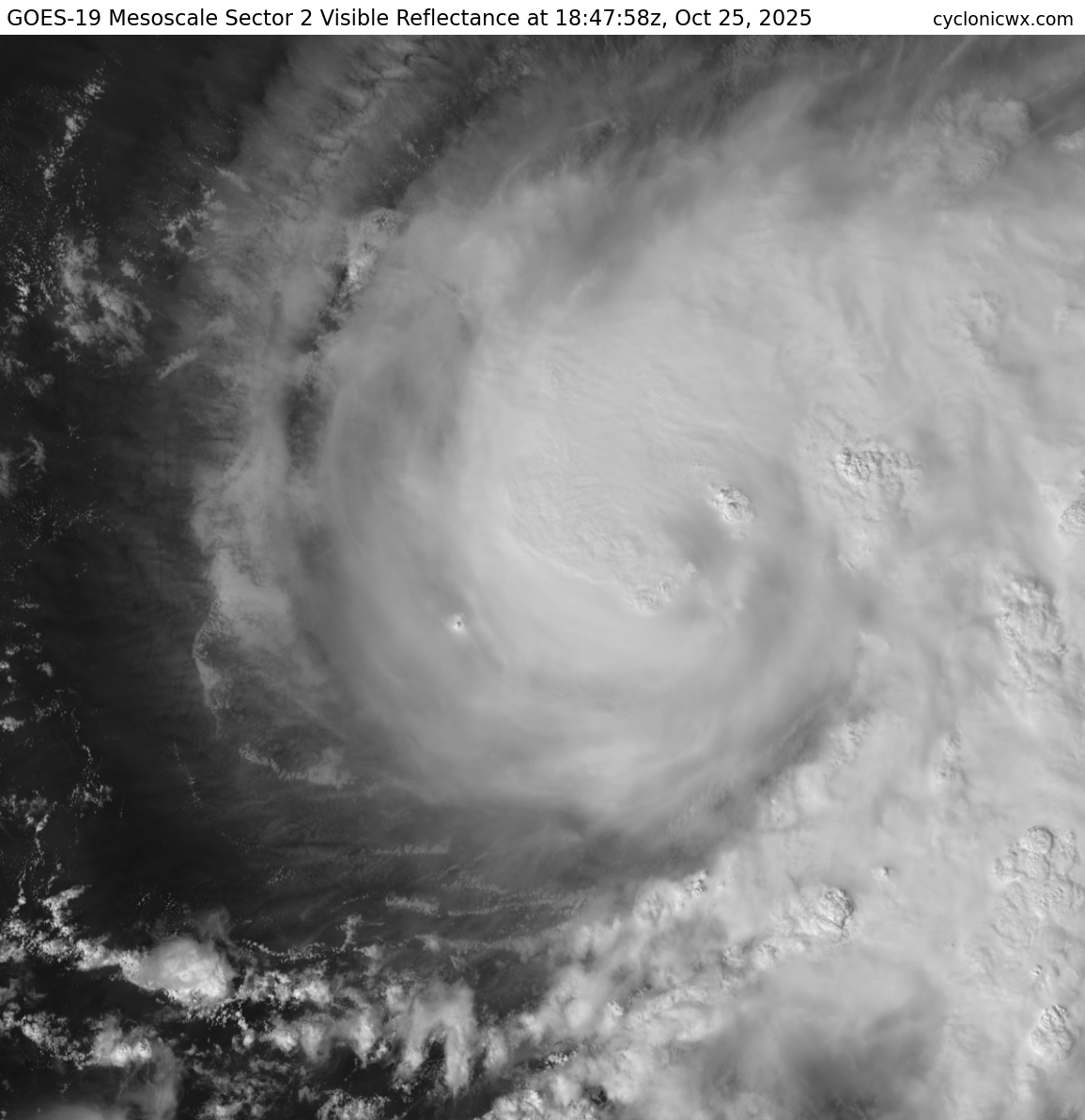
Updated bets on Google/12Z distribution (+3 mb, chosen based on the difference between google's mean point at 18Z and the current NHC b-deck estimate, which gives it an adjusted mean min. MSLP of 920mb); this puts it close to the HAFS-A run (921 mb). HAFS-B/12Z looks like it was initialized far too weak (991 mb if I recall) so I didn't reference it.
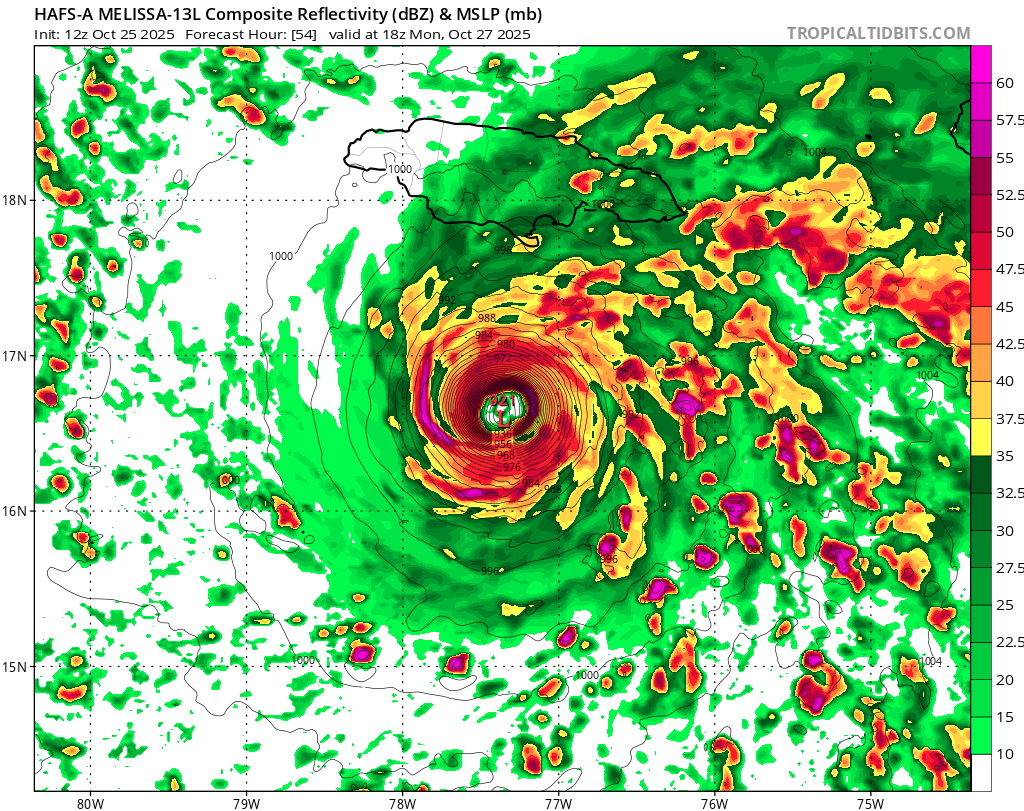
Using same ad-hoc method as above.. (google 18Z, HAFS-A,B and latest recon)
00:32Z 970.4 mb center drop (adjusted)
18Z google Unadjusted mean min. mslp: 919.540
2510252300 ( +16.46, -75.47) 90.7 969.0
18Z google run, 00Z point
970.4 - 969.0 = 1.4
min adjusted
919.54 + 1.4 = 920.94
18Z hafsa, 00Z point
970.4 - 976.5 = -6.1
min adjusted
933.9 - 6.1 = 927.8
18Z hafsb, 00z point
970.4 - 975.1 = -4.7
min adjusted
929.7 - 4.7 = 925.0
average of two hafs min adjusted
(927.8 + 925.0) / 2 = 926.4
weighting google and the combined hafs adjusted
0.6*920.94 + 0.4*926.4 = 923.124
adjustment to google mean min mslp:
919.54 - 923.124 = 3.584
Simple calculation then adjusting from Google 18Z ensemble:
Unadjusted mean min. mslp: 919.540
Adjusted 3.584 mean min. mslp: 923.124
Total models: 50
MSLP bin distribution (% of models):
< 899.5 : 2.0%
[899.5, 909.5) : 8.0%
[909.5, 919.5) : 26.0%
[919.5, 929.5) : 42.0%
[929.5, 939.5) : 14.0%
[939.5, 949.5) : 8.0%
[949.5, 959.5) : 0.0%
[959.5, 969.5) : 0.0%
[969.5, 979.5) : 0.0%
>= 979.5 : 0.0%
Edit update:
next recon (NOAA2 with the doppler radar) wont enter the storm area for another 4-5 hours (22Z). Notable remark for next recon:
3. REMARK: A SMALL UAS WILL BE RELEASED DURING BOTH NOAA P-3 TAIL
DOPPLER RADAR MISSIONS TASKED FOR 26/0000Z AND 26/1130Z.
adding pics and positions as we have 3 position fixes within the same 2 hour window from earlier now that will be useful reference for later on for the 12Z model comparisons and subsetting..
14:45 GPM (37Ghz) (0.29 deg rad for 95%):
16.55 N , 75.14 W
14:32Z METOP-B (0.43 deg rad for 95%):
16.34 N, 75.19W
13:08Z Recon (center dropsonde):
16.49 N, 75.0 W
~
14:45Z GPM-CORE 37 ghz pass...
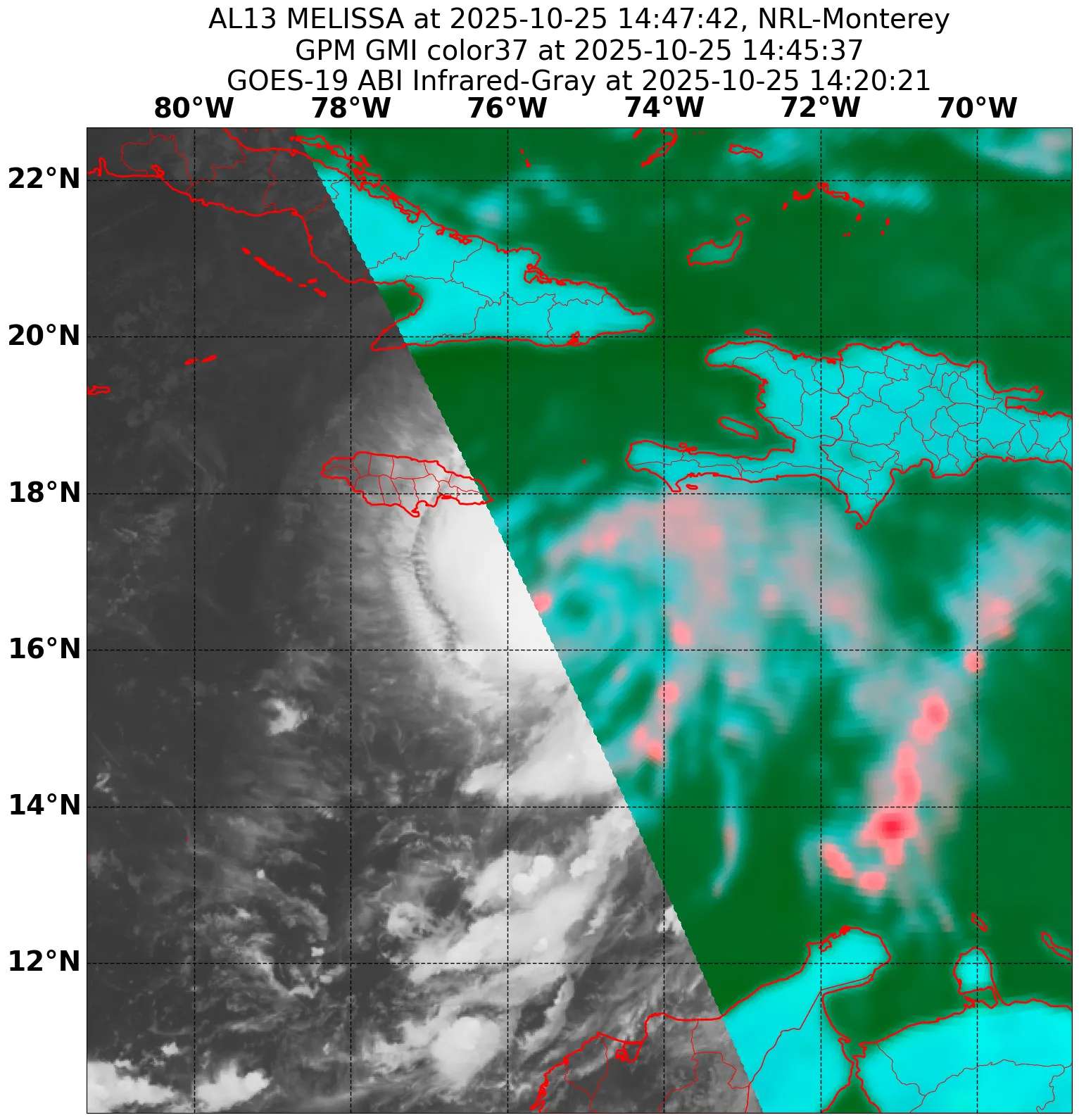
A 14:32 ASCAT (METOP-B) fix
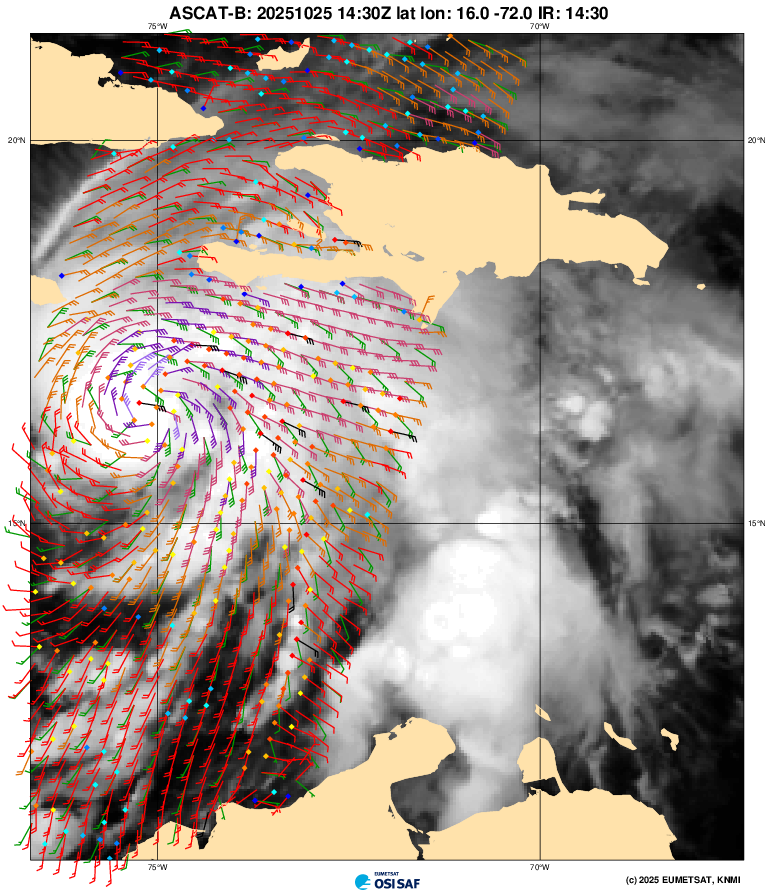
Their CIMSS (ARCHER) auto fixes (the 37GHz being most relevant for the low level center):
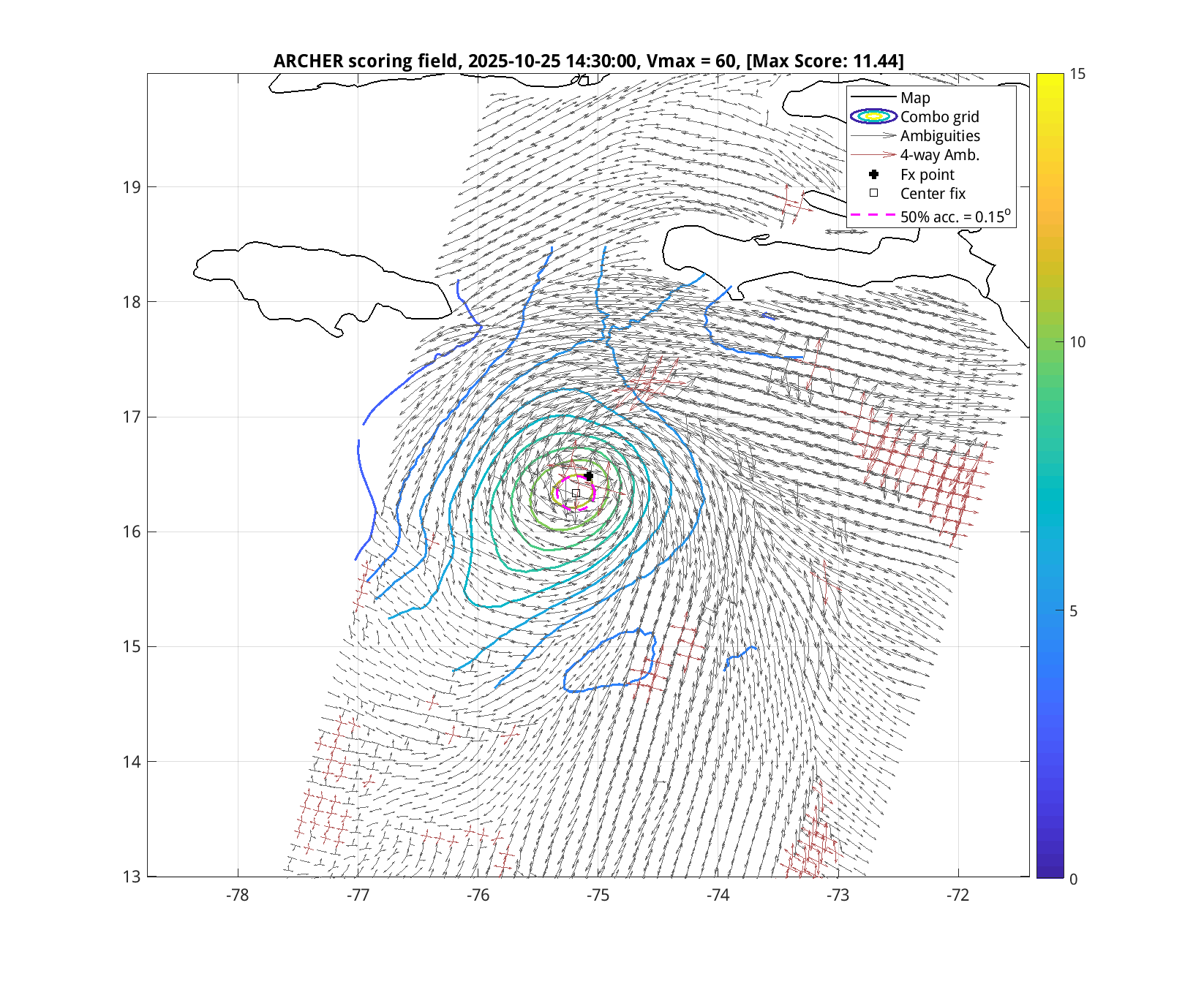
Not sure why the metop-b is labeled Ascat-A (looks like a typo):

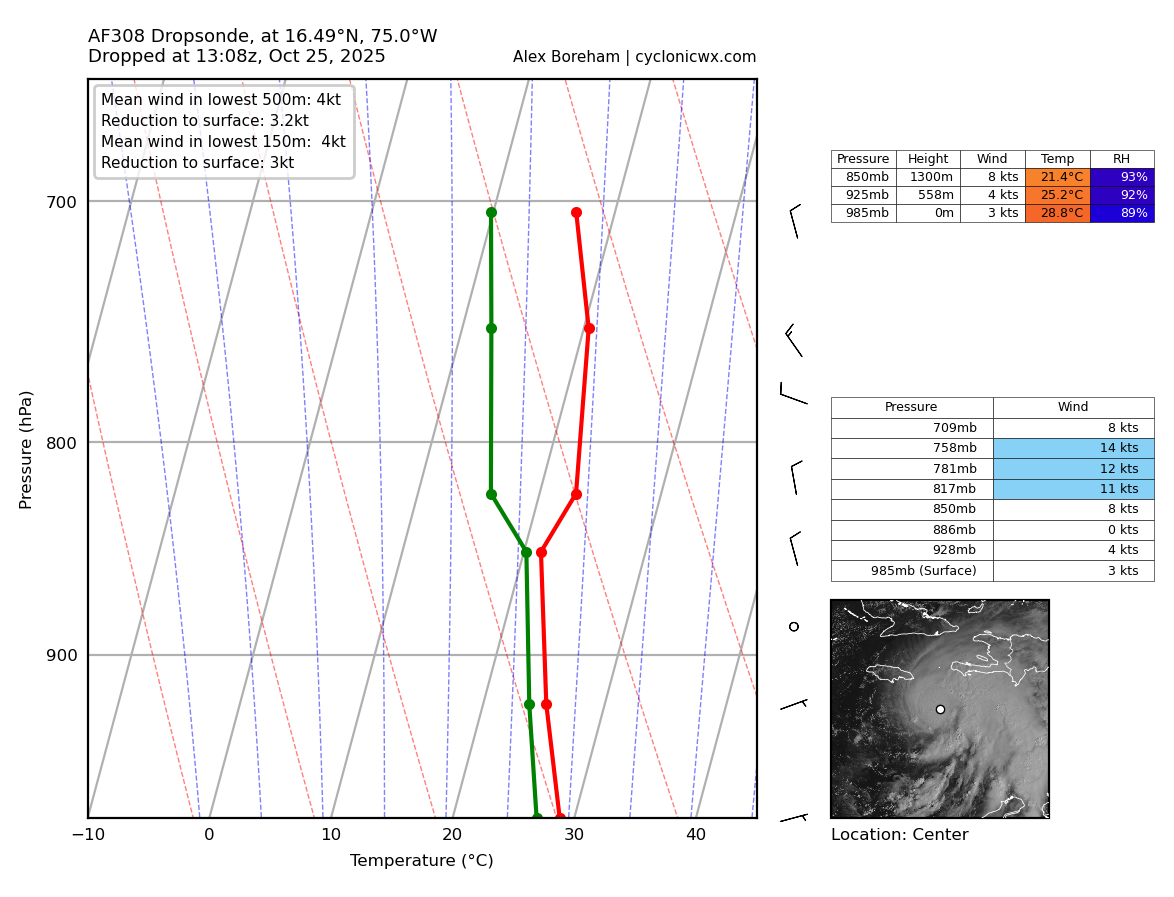
~
~
Earlier 10:50Z microwave imagery:
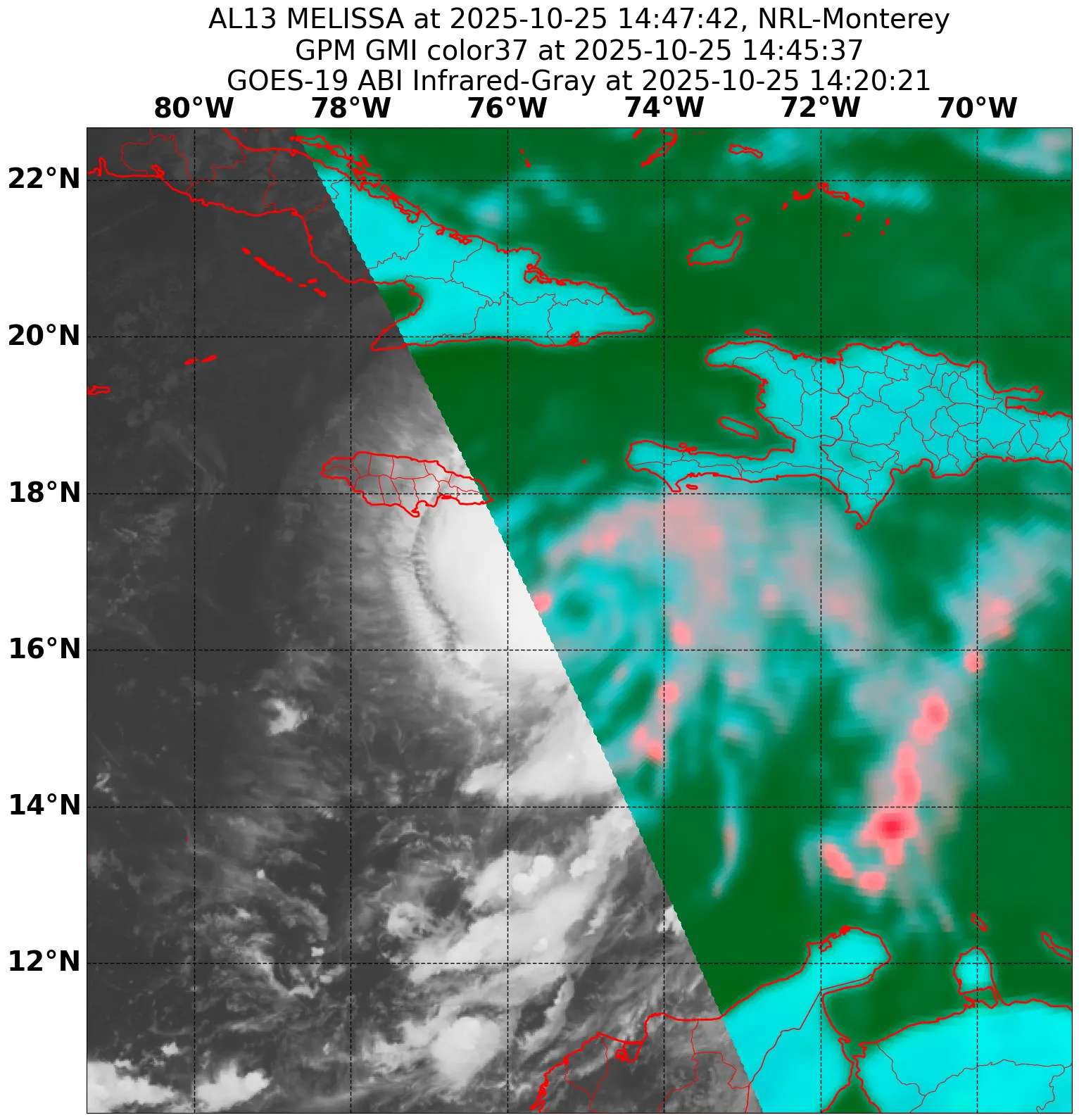
Still not cleared an eye... earlier microwave pass from 10:50Z showed a cyan ring so should expect RI to begin before the end of the day still but later than I expected last night.
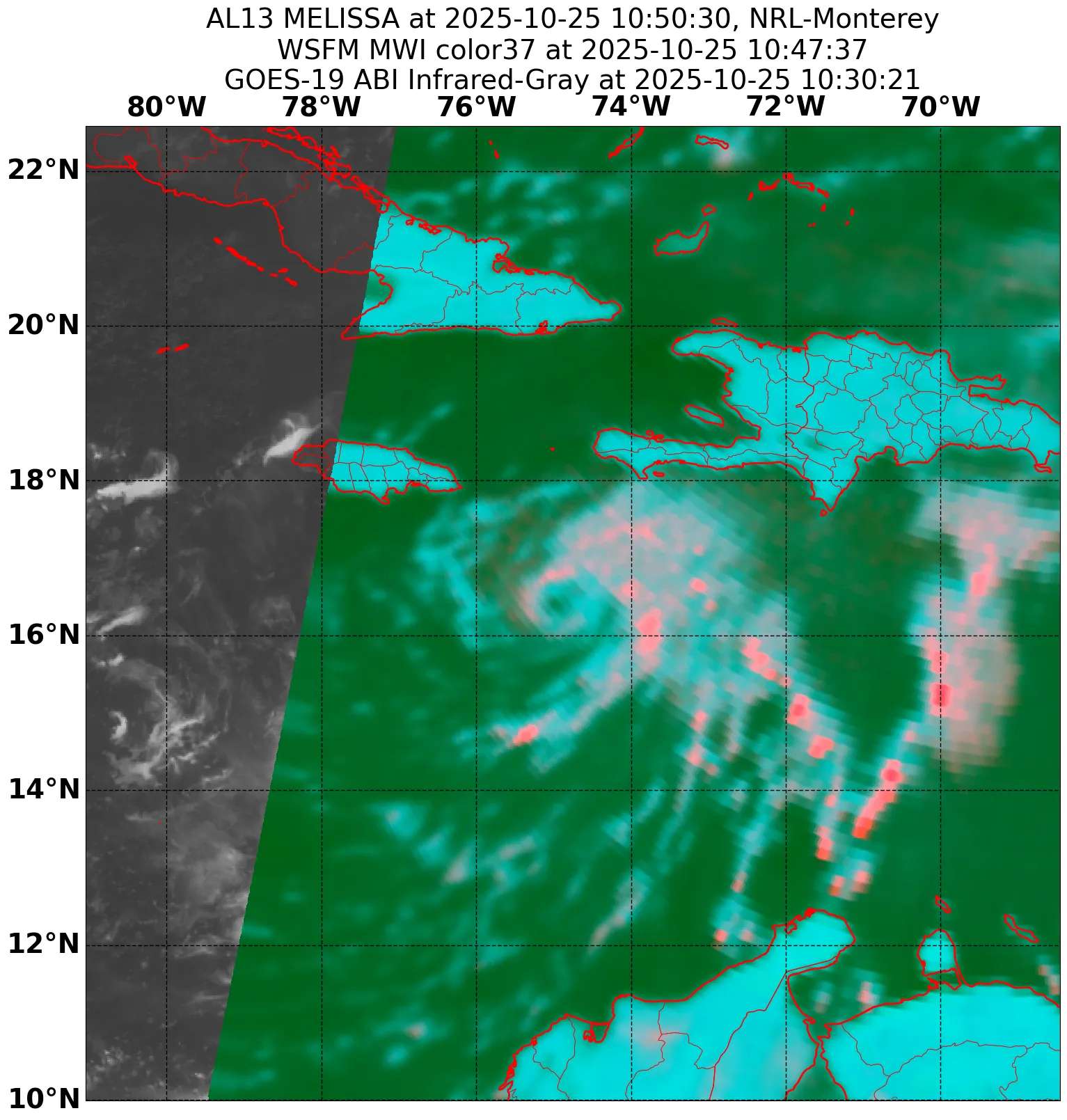
After betting lazily the last few times, I put some more effort this morning given I have more time..
~
Written earlier:
for the HY-2C 08:32Z pass, I roughly estimate the position near 16.44 N, 75.03 W
Based on the above, since 00Z it has tracked more NW than the W this morning (280 deg. instead of 305)...
For the older google 00Z run, this resulted the fix I had being ~10NM north of the 00Z run's mean track for 08:30Z
For the latest 06Z run, the fix is ~5 NM north of the mean track.
Based the apparent movement on satellite imagery assuming it has kept that more north west track, subsetting by eliminating about 20% of the tracks that steer SW for the next day doesn't change the distribution as far as intensity.
The tcvitals (and best track) that was fed innto the models for 12Z was 16.3 N, 75.0 W ( about 8-9 NM south of my above 08:32 surface center fix )
I note the HCCA 12Z tracks more directly westward but it tracks considerably less westward (but south of 17N) than the google mean before turning N then NE and landfalling on the east tip of Jamaica.
The HFAI, HFBI models look to be in fairly good agreement with each other tracking NW and then eventually W over the 2-3 days before turning north landfalling more towards the center of the Jamaican coast (but tracking NE slightly west of Kingston). This (like the runs last night) keeps them north of 17N during the westward period when they are most likely to greatly intensify.
ECM/06Z appears it was initialized at too weak an intensity (995mb, 41kt); the scatterometer pass mentioned above had at least a rain-flagged vector of 43kt, and the recon had much lower pressure values (CIMSS satcon for reference had 988mb and a vmax of 55kt). It takes a track similar to Google mean for the next day (NW then SW) and then W and NW (reaching 17N around Oct 27th 00Z) and then west again before a slightly more gradual curve NW, N, but as it approaches the Jamaican coast it takes a much slower track moving from the west part to the east part of the coast, before a NE turn crossing the eastern part of Jamaica.
based on the 12Z estimate of intensity, HWRF/06Z looks slightly too aggressive, and HMON/06Z far too aggressive, while HAFSA and HAFSB/06Z look a little under.
HWRF,HAFSA,HAFS all briefly dip down below 940mb. (HMON doesn't drop below 944mb)
~
Written later (around 15-15:30Z):
Finished writing after the 15Z advisory so I did glance at it but didn't really reference it for the below ... a bit surprised NHC has kept the 135 kt peak winds in their forecast (I expected a slight downgrade from the delayed RI so far and that the peak of the mean track intensity for google has dropped below 130kt now:
2510271800 ( +16.27, -77.89) 128.9 933.9
Still no eye from 15Z imagery
~
Latest recon from 13Z from the center dropsonde (985 mb) puts the center at 16.49N, 75W (slightly north of the fix I did earlier), and 11NM ENE of the google/06Z mean for that time; notably HAFSA/HAFSB 06Z appear to nail this position albeit with pressures +3-4 mb about for this time.
I do note that the extrapolated pressure from flight level winds was lower (982 mb) (and the 15Z advisory seems to keep it at 982mb), but importantly I don't reference the latest NHC estimated MSLP (the 15Z estimate) at this time for the below analysis:
Given this pressure estimate from the center dropsonde and the wind estimate from the SE eyewall, it seems significantly weaker than the Google 13Z mean track estimate suggesting either
Google/06Z was a bit too bullish on the timing for the RI, and as it still has not cleared out an eye as of 14Z sat imagery it looks like this is the case.
Google/06Z for last 8 hours for reference:
YYMMDDHHmm, (lat, lon), vmax10m, mslp
2510250600 ( +16.30, -74.90) 60.1 986.0
2510250700 ( +16.32, -74.94) 62.7 985.3
2510250800 ( +16.35, -74.97) 65.3 984.5
2510250900 ( +16.37, -75.01) 67.9 983.8
2510251000 ( +16.40, -75.05) 70.5 983.1
2510251100 ( +16.42, -75.09) 73.1 982.3
2510251200 ( +16.44, -75.12) 75.7 981.6
2510251300 ( +16.45, -75.18) 77.3 980.4
2510251400 ( +16.46, -75.23) 78.8 979.3
2510251500 ( +16.47, -75.29) 80.4 978.1
2510251600 ( +16.47, -75.34) 82.0 977.0
2510251700 ( +16.48, -75.39) 83.6 975.9
2510251800 ( +16.49, -75.45) 85.1 974.7
2510251900 ( +16.46, -75.50) 88.5 972.0
2510252000 ( +16.43, -75.56) 91.8 969.2
2510252100 ( +16.40, -75.61) 95.2 966.5
2510252200 ( +16.37, -75.66) 98.5 963.7
2510252300 ( +16.35, -75.72) 101.9 961.0
2510260000 ( +16.32, -75.77) 105.2 958.3
So given the Google/06Z track looks for the moment (+5mb) above the intensity estimate for 12Z, while HAFSB/HAFSA from 06Z look under (-3.5mb), I start by adjusting upwards the distribution for Google/06Z based on the center dropsonde (+5 mb).
For reference this is the original distribution at the moment (mean of 919.2 mb):
MSLP bin distribution (% of models):
< 899.5 : 4.0%
[899.5, 909.5) : 16.0%
[909.5, 919.5) : 30.0%
[919.5, 929.5) : 32.0%
[929.5, 939.5) : 14.0%
[939.5, 949.5) : 2.0%
[949.5, 959.5) : 2.0%
[959.5, 969.5) : 0.0%
[969.5, 979.5) : 0.0%
>= 979.5 : 0.0%
After +5 mb adjustmennt (mean of 924.2 mb):
MSLP bin distribution (% of models):
< 899.5 : 2.0%
[899.5, 909.5) : 8.0%
[909.5, 919.5) : 24.0%
[919.5, 929.5) : 34.0%
[929.5, 939.5) : 24.0%
[939.5, 949.5) : 6.0%
[949.5, 959.5) : 2.0%
[959.5, 969.5) : 0.0%
[969.5, 979.5) : 0.0%
>= 979.5 : 0.0%
Considering I have less confidence in the far westward HWRF track and the HMON RI that is too early, I rely on HAFSA, HAFSB 06Z for a further final adjustment.
The min MSLP HAFSA/B from 06Z runs average 938.5mb (938,939 mb respectively); adjusting them downwards (-3.5mb from the center dropsonde) yields 935.0 mb.
So 935.0 from the late adjusted HAFSA,B and 919.2 from Google is a 15.8mb difference.
HAFSA/HAFSB seem for the moment gotten the current position better than Google (as well as intensity), but I still speculate (based on looking at various tracks -- EPS/00Z and ECM/06Z) that the HAFS models might still be a bit poorer getting the steering (ending up a bit too far north when they start tracking west, and thus perhaps underestimate the RI) for the next day or two. (Skimming the 15Z NHC discussion seems to follow this general scenario, but they reference both GDMI and ECAI for track).
Given all of the above, I subjectively now weight the min. adjusted pressures from HAFS and Google 0.4, and 0.6 respectively yielding my expected mean min. mslp of:
(935 * 0.4) + (924.2 * 0.6) = 928.5 mb
So adjusting the original Google 06Z distribution by a final 928.5 mb - 919.2 mb = +9.3 mb for the HAFS adjustment from the original mean yields the following final distribution (actual mean of 928.506 mb):
MSLP bin distribution (% of models):
< 899.5 : 0.0%
[899.5, 909.5) : 4.0%
[909.5, 919.5) : 18.0%
[919.5, 929.5) : 32.0%
[929.5, 939.5) : 32.0%
[939.5, 949.5) : 10.0%
[949.5, 959.5) : 4.0%
[959.5, 969.5) : 0.0%
[969.5, 979.5) : 0.0%
>= 979.5 : 0.0%
I've updated sharply to this now..
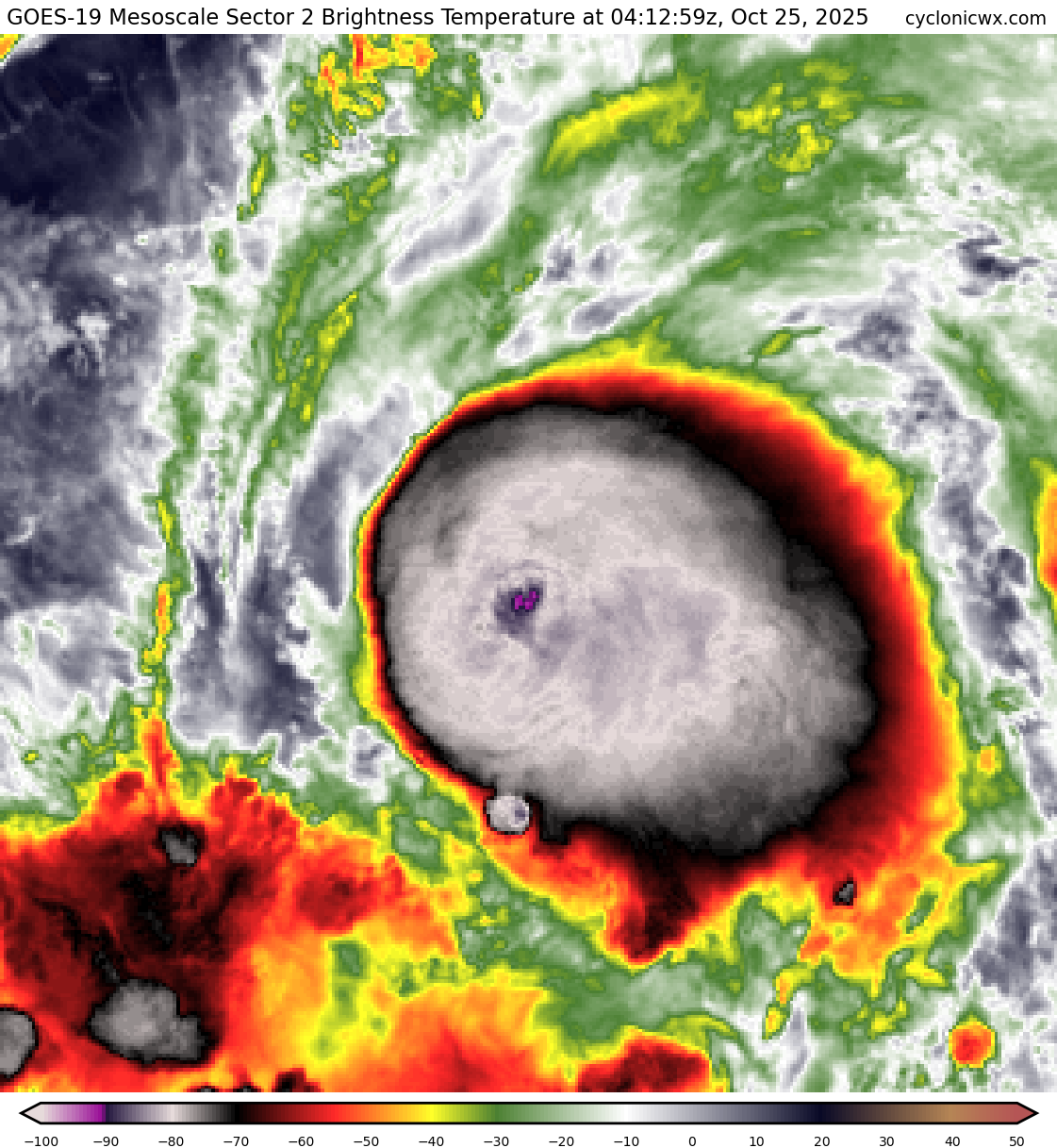
Looking at one 1min meso from last 30 mins (03:54 to 04:16Z) I’ve seen some bursts rapidly rotating around each other (potentially like mesovortices) and based on the warm center reaching 6C and the smaller more symmetric top… these signs point to me RI is about to begin.
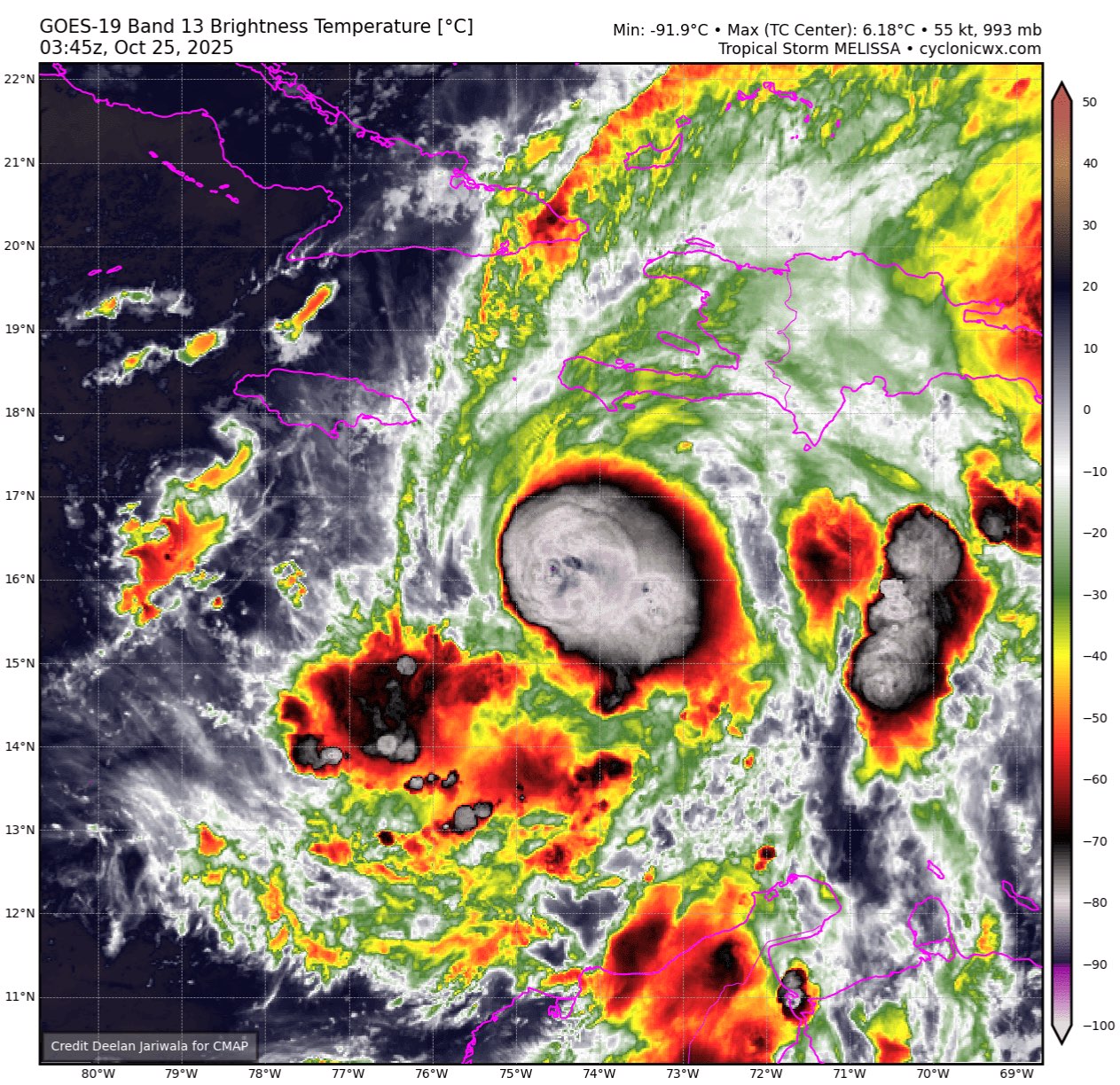
edit:
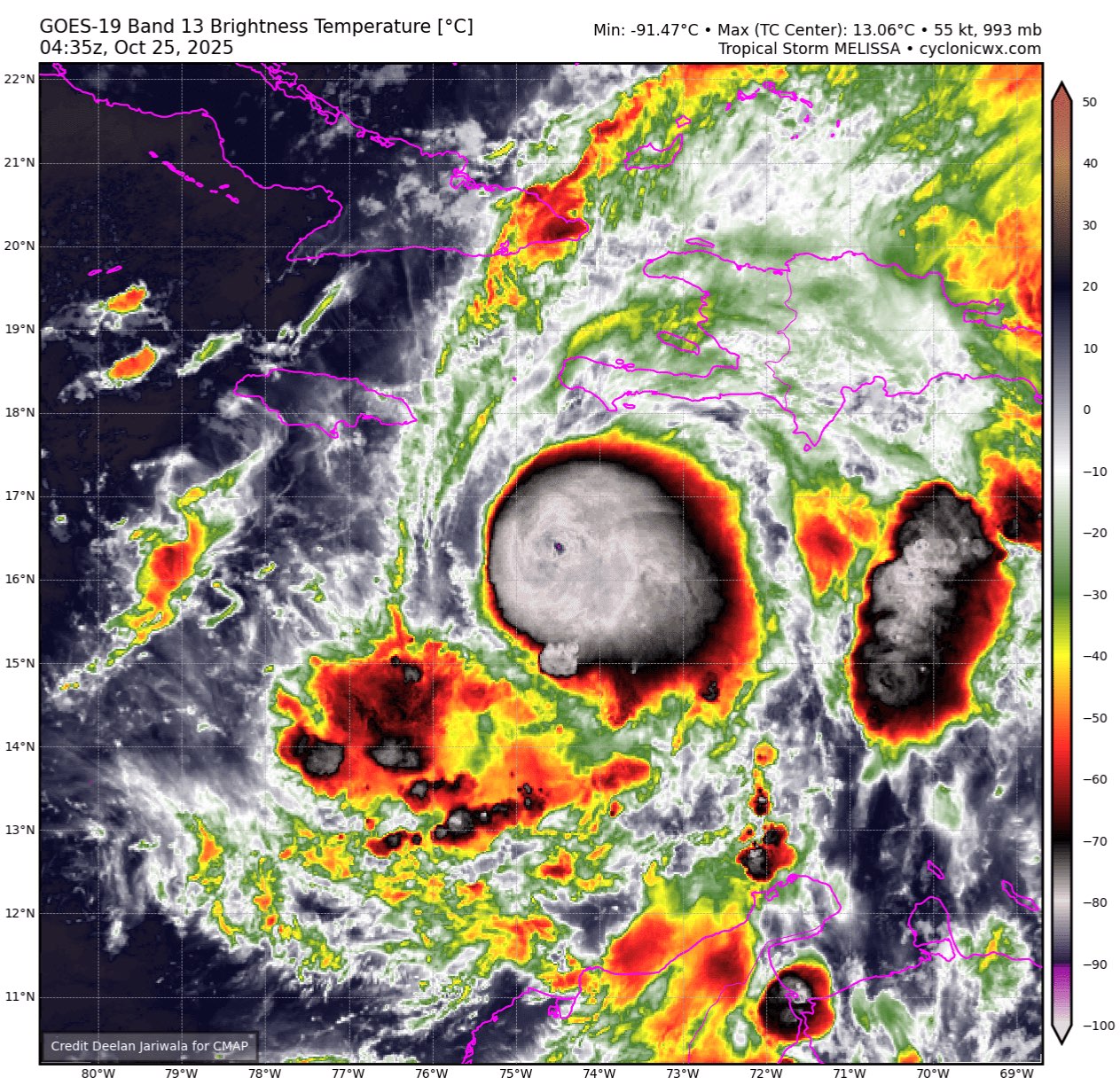
latest recon up to 05Z center drops missed the Surface center, and although the 700mb level winds weren’t that impressive it seems to have been during this reorganization period.
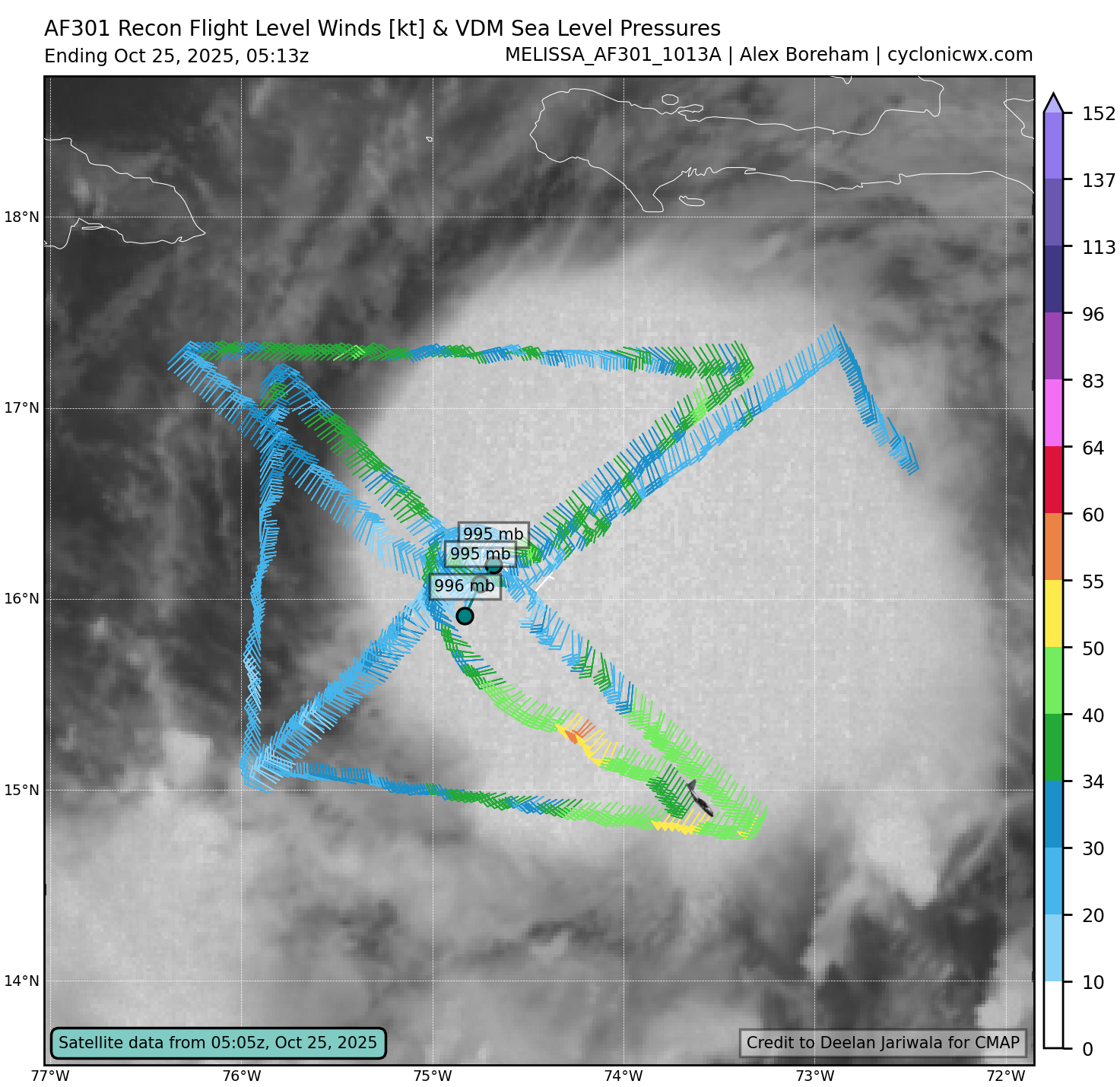
latest one from 04:30Z supports that it is indeed strengthening … (986-987 mb after adjustments).
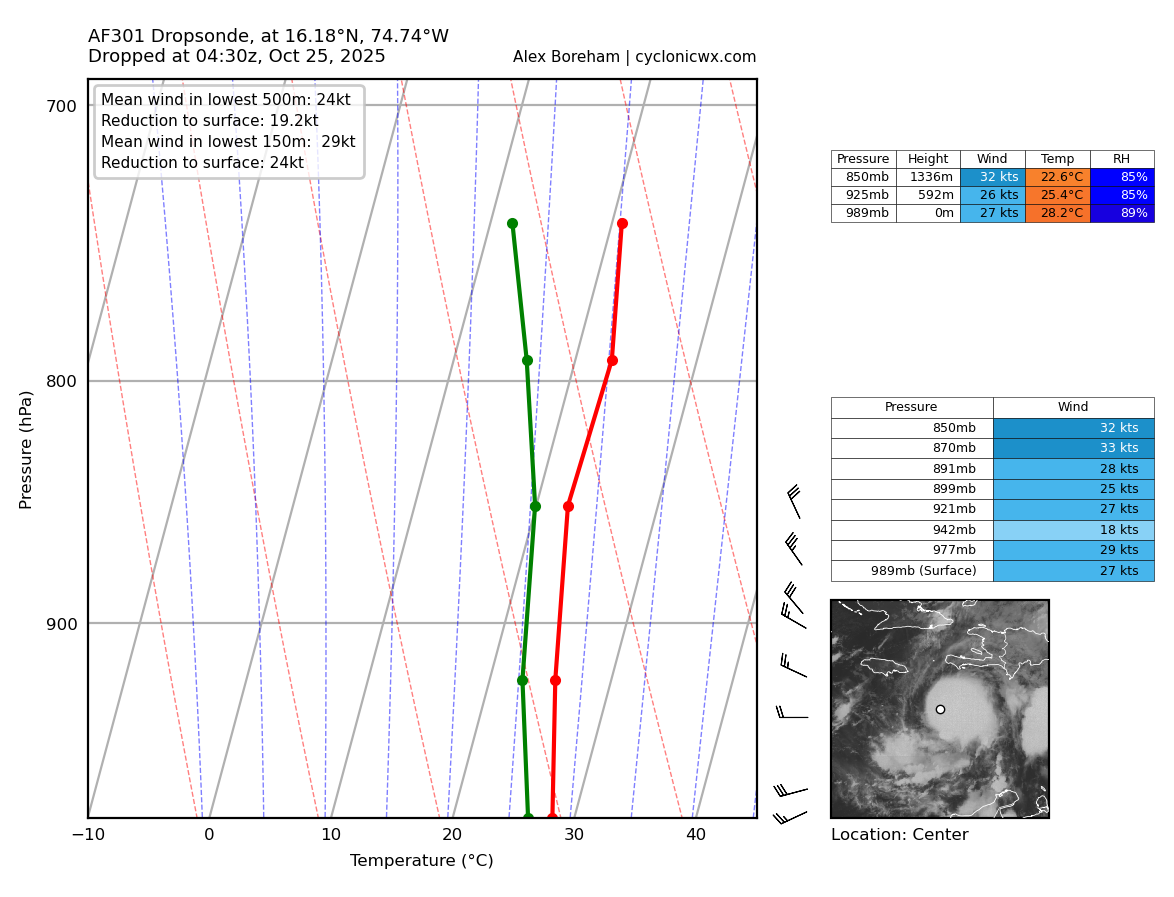
Edit for reference where they circled around a bit for the center (at 700mb)
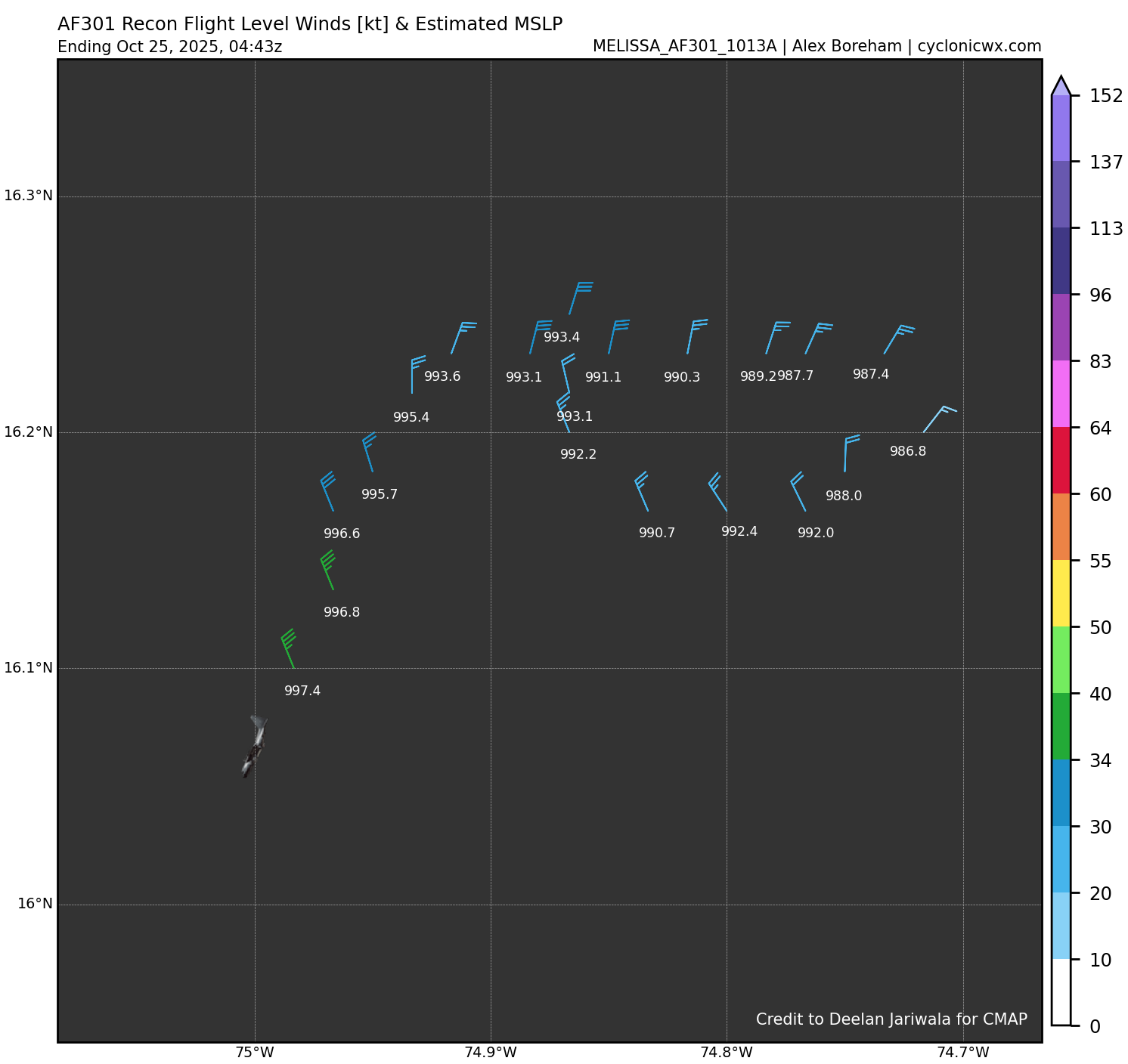
Regarding the update to 50 kt... and latest 18Z position Google 06Z seems to have done a good job with both respects; subsetting on 06Z either of these doesn't reveal much change in track or any changes with intensity as far as I can tell. I've lazily bet according to it.
Seems to being getting organized slightly faster than I expected though (based on looking at ECM yesterday so its understandable).
12Z Google should be out any minute...
Regarding the update to 50 kt... and latest 18Z position Google 06Z seems to have done a good job with both respects; subsetting on 06Z either of these doesn't reveal much change in track or any changes with intensity as far as I can tell. I've lazily bet according to it.
Seems to being getting organized slightly faster than I expected though (based on looking at ECM yesterday so its understandable).
Looks like the steering has changed very slightly with 12Z google mean shifting slightly east again, as several of the cluster of SW outliers from 06Z (similar to ECM 06Z) have moved away from that (this is what I think I would have expected given the trend in the track lately since last night, with it shifting eastwards, and with me having less confidence in that ECM solution with the shift of the system's current position SE) (there are still some more further westerly tracks and a few outliers tracking west of Jamaica), and a few more outliers on the east side of Jamaica with east tracks, but overall the tracks appear to be more clustered now towards the mean in terms of approach to Jamaica and eyeballing it there appears to be a slight shift of the members eastward also. The recurve angle for the NE mean track in 3 days seems have to become a bit more towards the east (still NE). I've lazily again bet mostly according to its distribution.
21Z NHC advisory now has it 12 hours at peak cat 4.. waiting for discussion..
FORECAST VALID 27/0600Z 16.5N 76.6W
MAX WIND 135 KT...GUSTS 165 KT.
64 KT... 35NE 30SE 25SW 30NW.
50 KT... 65NE 60SE 40SW 55NW.
34 KT...160NE 160SE 90SW 120NW.
FORECAST VALID 27/1800Z 16.8N 77.4W
MAX WIND 135 KT...GUSTS 165 KT.
64 KT... 45NE 35SE 35SW 40NW.
50 KT... 90NE 80SE 60SW 70NW.
34 KT...180NE 170SE 100SW 120NW.the 18Z regional models have come in on tropical tidbits, don’t suspect they are too useful yet beyond indicating what they think the environment will be like based on a scenario where the track is slightly further north when they track west — the hafs a and b are both a degree north of the earlier 12Z google during this timeframe — HAFSA deepening the most on close approach to Jamaica (HAFSA tracks a bit further west before recurving so it is deeper)
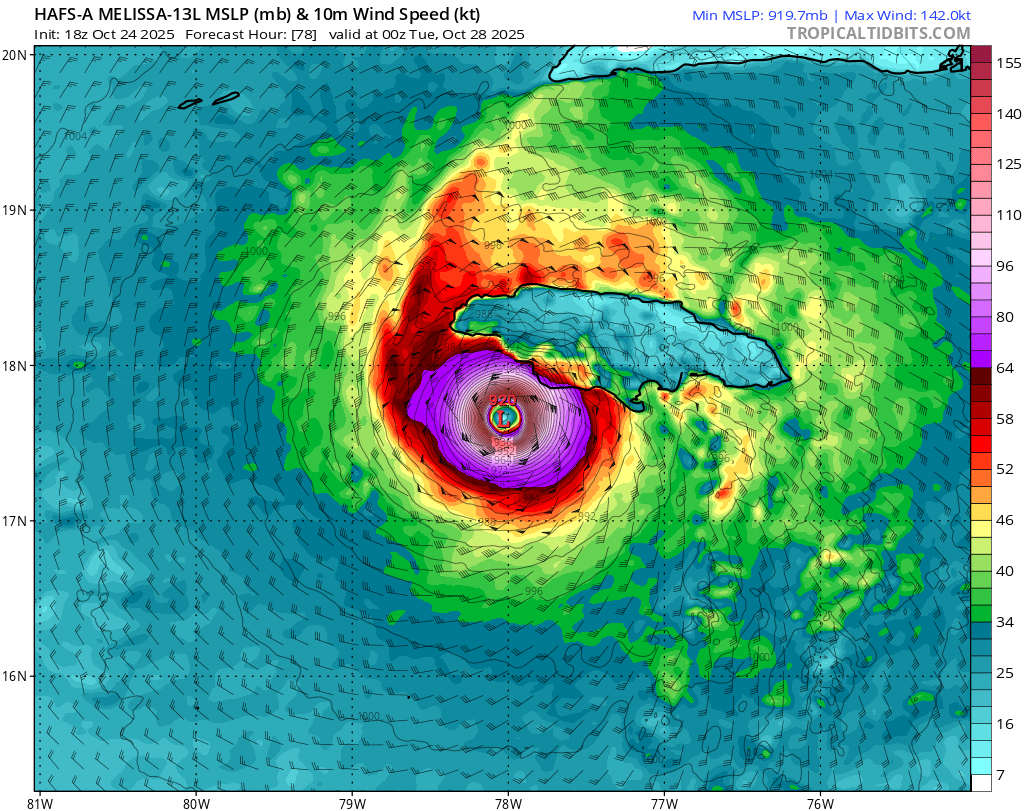
The more disorganized convection together with the elongated 18Z scatterometer pass from earlier seems to suggest that the earlier appearance that it might organize early was perhaps premature.
There was good reason to think so based on the amount of convection visible from satellites imagery, and structural data from microwave imagery and microwave sounders.
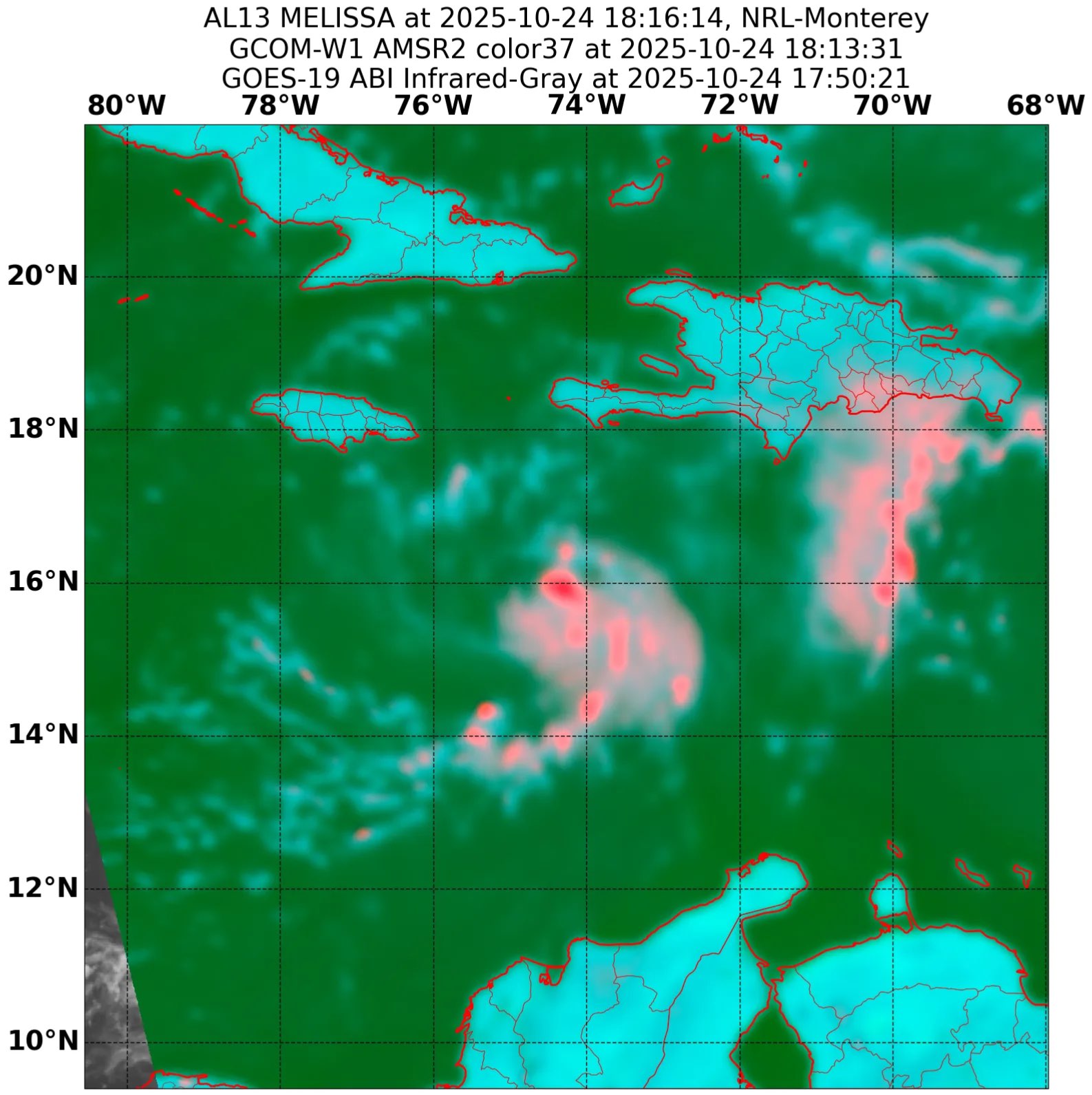
Own chart from interpolating using a deck / good pass from noaa21 data from OSPO showed deep convection ( 6C ) but the pattern since then has changed.
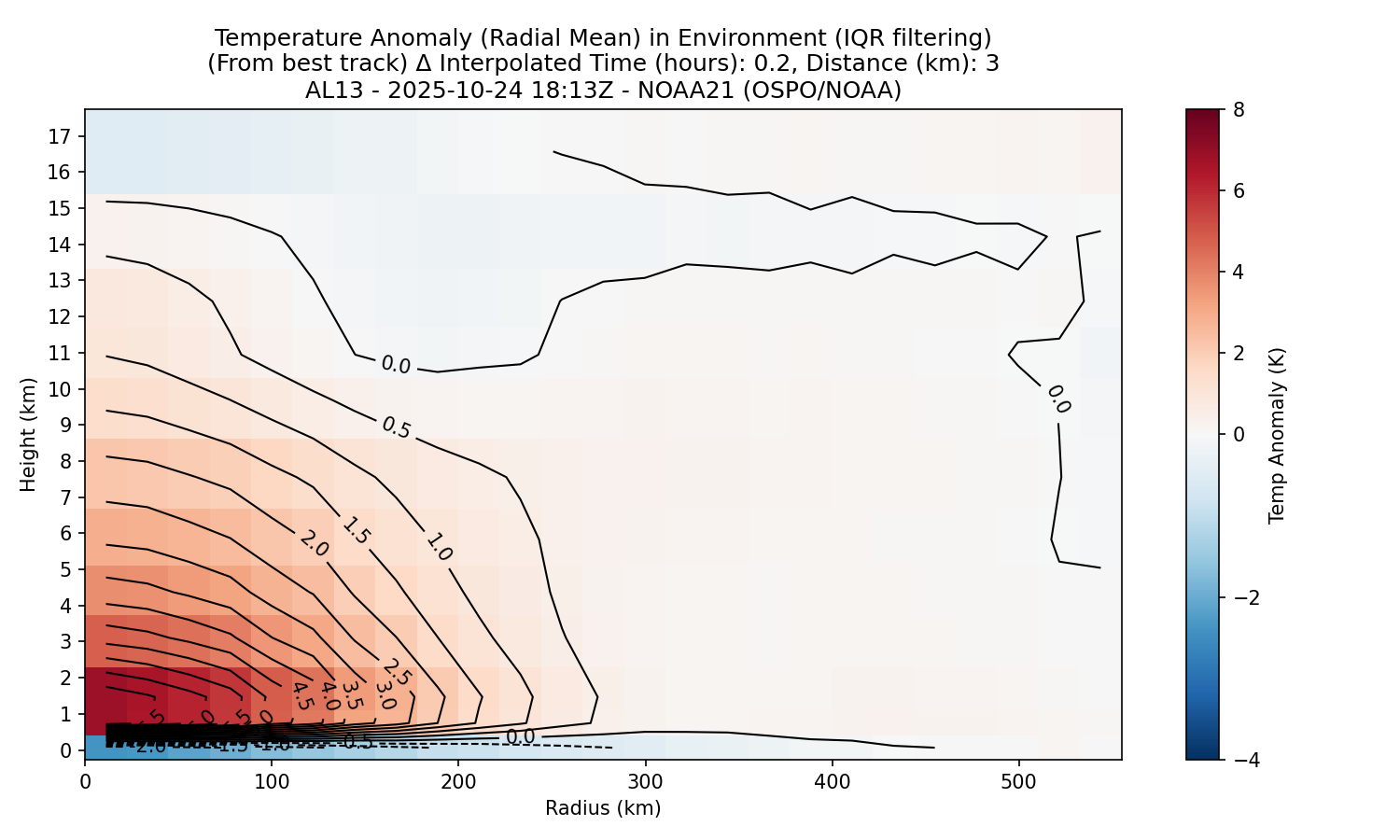
Current tops have warmed slightly and the appearance subjectively looks like the reorganization will take a bit longer. As the NHC discussion mentioned earlier it seems the RI could take place at any time..
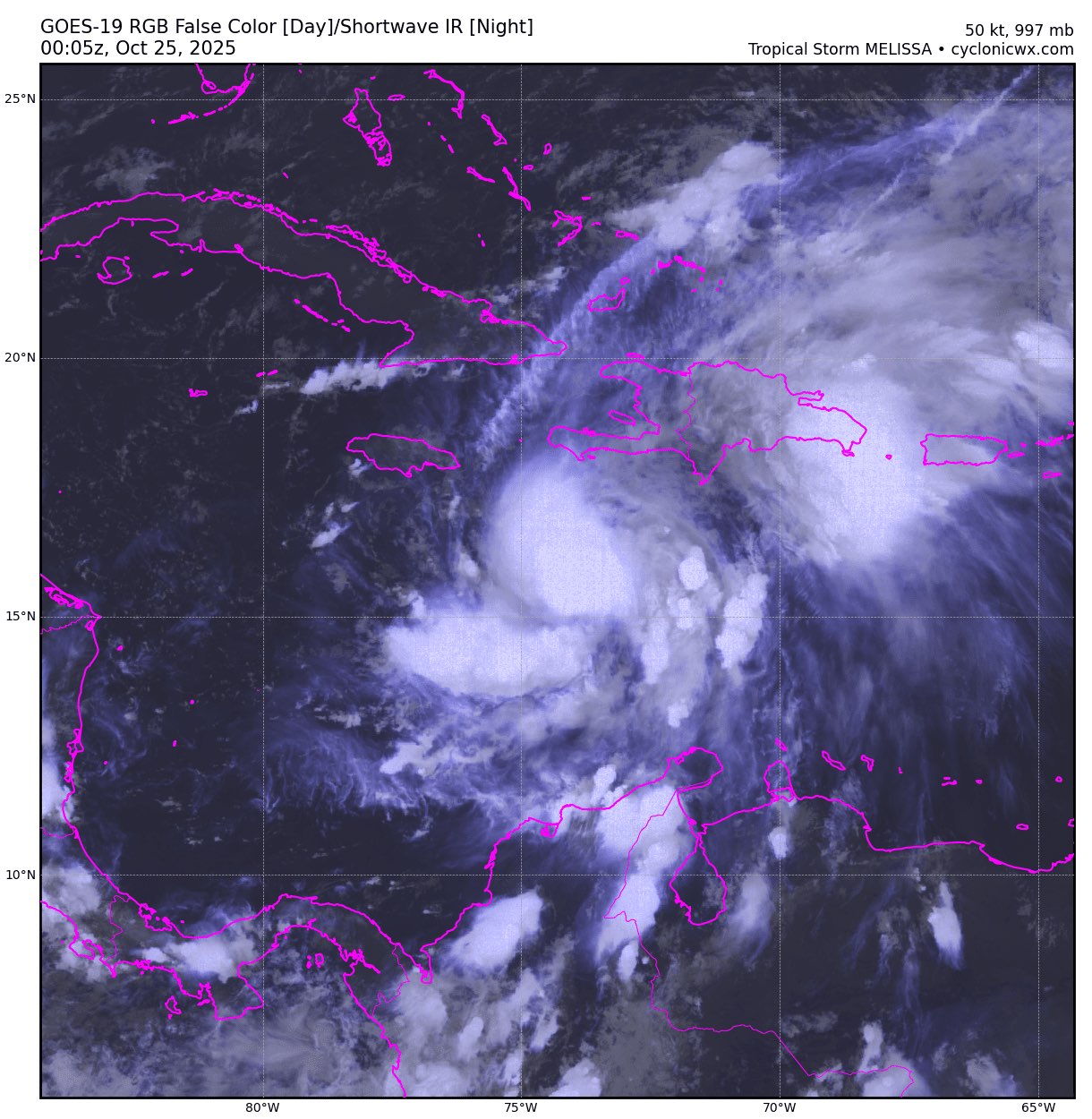
Current recon looks like it missed the center with the center drop based on the surface wind speed..
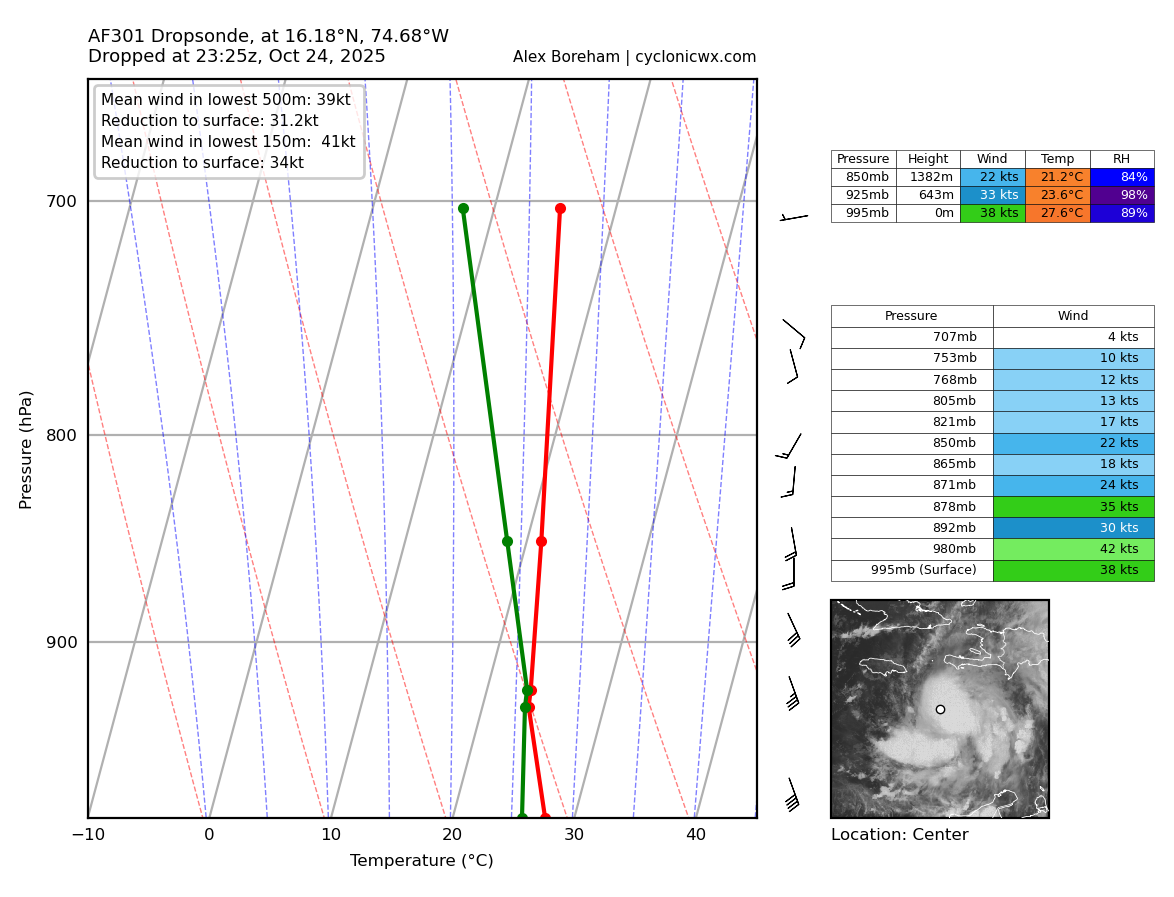
Should have a good idea of the center circulation from at least one of the metop passes in 4-5 hours (02Zand 02:48Z). I speculate this should also help GFS and the regional models for the 06Z runs to come into better alignment with ECM, google on track as data may have been a bit sparse for the scatterometer data they have been ingesting, and the system should come into better alignment by then per my expectation a day ago or so) so they should start to be more useful by then.
Waiting for google 18Z to come in….
Updated bets based naively on Google/18Z tracks:
compared to 12Z they have clustered closer together in terms of landfall but there might some more meandering/randomness on its track westward (appears to have shifted a tiny bit west despite the most westward outlier from 12Z disappearing) (not sure how much the meandering variation is legitimate or AI oddity or possibly from something my tracker might be doing).
The peak mean intensity in terms of wind speed based on mean track has dropped a bit now (from 133 to 131) (perhaps some disagreement on timing), but instead the >=130 kt mean track points spans 24 hours now (27/00Z to 28/00Z). Probabilities for this market have increased in terms of it deepening further though.
@SaviorofPlant Does it include everything NHC issues on the webpage like update statements (which are under public advisory column, and they often mention their hourly pressure estimates from recon/etc)?
@parhizj Yes, a special update advisory like the one just issued (https://www.nhc.noaa.gov/text/refresh/MIATCUAT3+shtml/241630.shtml?) would count for resolution of this market.